Brain Teasers - Do you know?
Brain Teasers - Do you know?
- Do you know?
- Can a mosquito transmit AIDS?
- Why are hill-stations cooler even though they are closer to the sun?
- Cold Start
- Space age materials
- Weather Talk
- Rudra Veena
- The Sun In Your Hands
- What does the monkey know about the taste of the Ginger?
- A long journey back home
- Monarch and viceroy
- Magic of Movies
- Bubbling With Fun
- Monsoon
- How do I make clear ice?
- Why is southern exposure so sought after when searching for a house in any city?
- Ozone is good or bad?
- What is plywood? Why do people use it so much?
- Why do bananas turn black if you put them in the refrigerator?
- How are stripes put into toothpaste?
- How does milk sold in cardboard cartoons stay for six months without boiling or refrigeration? P. Hareesh, Mumbai
- Why do sea water fish die if they are put into the river?
- Why do we sweat in summer?
- Why can we feel our pulse only at certain points along our body, like the wrist?
- The Games of Chance - SNAKES AND LADDERS
- Make your own board
- Question: What’s so hot about fractals, anyway?
- The Bewitching Insect World
- Organic Agriculture
- Rain Harvesting- Simple yet Effective
- Animal Scales
- Wildlife
- Illusions
- Don’t blow it!
- The Eradication of Smallpox
- Other Diseases and theri Eradication
- The Story of Malaria
- Does the hole become larger or smaller or does it remain the same size?
- What would happen to the water level if you threw the rocks into the water?
- Why is it easier to maintain your balance on a moving bicycle than on a stationary one?
- Will an igloo eventually melt if heated by stove or other means?
- Why don’t trains traveling across open countryside get struck by lightning during thunderstorms?
- Why does a train travel slowly over a bridge?
- Is the sea blue because the sky is reflected in it?
- Why does our nose have mucus?
- When ironing clothes, why do we sprinkle a little water on them?
- When you look at something beyond a fire, what you see seems shimmering and hazy. Why?
- Why do mustard seeds splutter when put into hot oil?
- We need oxygen to live, but how much of it? Is it harmful to breathe 100 percent oxygen? What will happen?
- How big should a shooting star be in order for us to see it with our eyes?
- I know it has something to do with our ears, but what exactly makes people dizzy when the spin?
- There is a strong, funny smell after it rains. Sometimes it is a good Smell, and sometimes it is unpleasant. What causes this smell?
- We often read about windows that are “bulletproof.” Does bulletproof glass really exist, and if so, how does it work?
- If global warning causes the polar ice caps to melt, how much will the oceans rise?
- The sky is blue, but why are sunsets red and orange?
- Why is it easy to stay on a bicycle while moving, but impossible to maintain the balance once it stops?
- Why are most planets round, with somewhat flattened portions at the poles?
- Is it possible to generate electricity directly from heat?
- I see that an old black and white movie is being released in colour now. How can they manage to do that?
- Why do those long white clouds form behind jets flying high over head?
- How fast does human hair grow?
- How does a candle work?After all, wax does not burn without wick, and a wick burns out in seconds if not enclosed in wax.
- People talk of ‘sixth sense’ since we are supposed to have only five senses. Is it true that there ‘only’ five senses?
- Why does paper become brown after some time?
- Why do the plugs on some appliances have two prongs and others have three prongs?
- There are so many toothpastes being advertised. Each of them claims to be different from others. Are they really different from each other?
- When it rains, sometimes the drop size is small and sometimes it is big. Is there such a thing as the largest drop size?
- We feel as if our ears got-air locked when we ride a giant wheel or when we travel in flights. Why?
Do you know?
Can a mosquito transmit AIDS?
Vignesh Babu, Madurai says No, it cannot. But then you are going to ask: how come it manages to transmit malaria and not AIDS? There is an interesting answer. When a mosquito bites you, a malaria parasite in your blood can end up inside the mosquito’s stomach. But when the mosquito bites someone else, it does not inject any blood into him. So how does the malaria parasite manage to get to him? It so happens that by a long and complicated process, the malaria parasite (or its descendants) manage to reach from the mosquitoes stomach to its salivary glands. When the mosquito bites the second person, some of its spit can manage to get into his/her blood. Along with the spit comes the malaria parasite!
Why are hill-stations cooler even though they are closer to the sun?
The temperature of different places on the earth depends on many things. First, the amount of sunlight falling on the place. This differs with latitude. At high latitudes, sunlight is always falling at an angle, so that the same sunlight is distributed over a large area, making the place cooler. Secondly, the air transfers heat from one place to another by convection. (Conduction by land is less important.) Since the air at a height is thinner, it transfers less heat to a higher place. For every 300 metres gained in height, the thinness in air means a drop in temperature by 2˚c. So Bangalore, for instance, ought to be 4˚ lower in temperature than Chennai. Other factors like winds also play a role. The distance to the sun is unimportant. Compared to the distance between the earth and the sun, a few hundred meters hardly matters.
Cold Start
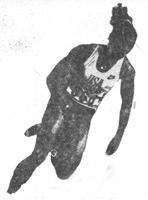
Having a cold bath improves long- distance running performance! So say team of Australian scientists led by Frank Marino. The scientists asked four runners to sit in a bath of lukewarm water for an hour, during which time they lowered the temperature of the water from about 29oC to 23oC. The athletes then ran on a treadmill for 30 minutes in a warm room. Four other runners who did not undergo the chilling treatment also ran under the same conditions. Three days later the two groups were swapped and the treadmill test was performed again. In both cases, the chilled athletes ran between 300 to 500 meters more during the 30 minutes on the treadmill than ones who had not been chilled. This amounts to a difference in performance of about 5%. The scientists believe that the improvement in performance is a direct result of the lower body temperature of the athletes. After Chilling, the athlete’s inner temperature had dropped to 36.5oC (from 37oC) and their skin temperature was as low as 27oC. Sustained physical activity generates heat in the muscles. This is carried away in the blood to the skin, which is closed by sweating. Pre-cooling may allow more blood to stay in the muscle, delivering glucose and oxygen. Will we see refrigerated rooms out on the race track at the next Olympics?
Space age materials
Two strange materials made news recently. The first is zirconium tungstate. This solid actually contracts when warmed. Unlike all other solids which swell up. Researchers believe that when the oxygen atoms in this substance vibrate more- such as when they are heated- they pull other atoms closer together. The second material is metallic compound made of yttrium and palladium. Yttrium is used to make superconducting compounds, where palladium forms a protective layer to keep the yttrium from reacting with oxygen in the air. Normally, the yttrium-palladium-compound is shiny, like a mirror. However, when exposed to hydrogen gas, the metal turns transparent on a few seconds. Though they are yet to find applications, both materials have promptly been patented.
Weather Talk
Why do we need weather observation at all? These are required to compile and document data on the continually changing nature of water; to forecast weather; and to aid operations such as agriculture, fishing, aviation, shipping, water resource management, disaster warning and pollution management. Weather instruments have been used for a long time. It is said, for instance, that rainfall was measured in India as early fourth century B.C. Nevertheless, most references to weather were in qualitative terms: light or heavy rain, cloudy or fair skies, dry or humid air. Instruments weren’t used in any serious manner until the seventeenth century, when measurements started to be taken.
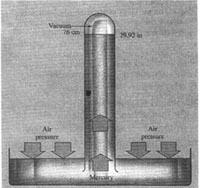
Measurement of rainfall
First let us take a look at how rainfall is measured. The rain gauge, which is used to measure rainfall, is one of the more intuitive weather instruments. Rain caught in a funnel on the top of the rain gauge runs down into a measuring cylinder below where the rainfall amount is measured. The information is then sent back to a base unit where the amount of precipitation is digitally displayed and recorded.
Measurement of temperature
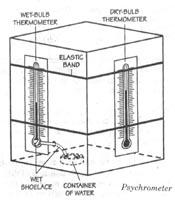
A common household activity is to measure body temperature of a person, especially when it is suspected that the person is ill. The thermometer is used for this purpose and it takes advantage of the fact that the volume of a material (solid, liquid or gas) changes proportionate to temperature, other conditions remaining the same. It consists of a liquid (mercury) in a thick bulb at the bottom connected to a very narrow tube. When temperature rises, mercury in the bulb expands so that it fills the narrow tube. The extent to which the tube gets filled (its volume) depends on the temperature. The narrow tube is calibrated to show the exact temperature reading based on the level of mercury. In order to measure temperature, there needs to be a temperature scale with standardized units. There are three scales used depending on the purpose and the geographical region Celsius, Fahrenheit and Kelvin. Can you guess why mercury is commonly used in household thermometers? Electrical resistance thermometers are being increasingly used these days to digitally record temperature. These thermometers consist of a wire made of material such as platinum or nickel whose resistance changes with temperature. The resistance of the wire is measured using additional circuitry and translated into a value in one of the above units.
Measurement of air pressure
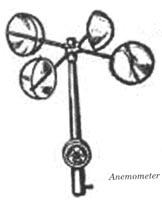
Pressure is defined as the amount of the weight applied per unit area. Thus air pressure is calculated by measuring the weight of the air column above us. The interesting thing is that weighing of air pressure didn’t occur until people believed in its absence, ie a vacuum. In the seventeenth century, a Roman scientist Berti constructed the first barometer when he filled a huge glass tube several storeys high with water, closed the top and opened the bottom into a pail filled with water. The water in the tube dropped to a certain point, with the water flowing into the pail, and then stopped, leaving a gap called vacuum. Before we understand how atmospheric pressure is measured in this experiment, let us see what would happen if the top of the tub was open. The water column would drop until its height is equal to the height of the water in the pail. This is because the weight of the air column on top of the water in the tube is the same as that on top of the water in the tube is the same as that on top of water in the pail. In the case where the top of the tube was closed, there is no air column applying pressure on top of the water in the tube. But since there is atmospheric pressure being applied on the water in the pail, the water column in the tube will settle at a height whose pressure on the water in the pail below is equal to the atmospheric pressure. Thus the atmospheric pressure is measured by measuring the height of the water column. In this experiment, the water column stood at roughly 9m. It is very impractical to have such a huge water column measuring pressure. A more practical version of this barometer is to use mercury instead of water. Can you guess why? These days aneroid barometers are more common. Aneroid barometers measure pressure using the expansion and contraction of a sensitive bellow (which is similar to the lungs in the human body) held open by an internal spring. Nevertheless, atmospheric pressure is commonly referred to in terms of the height of the mercury column. Meteorologists, however, commonly use a metric unit called millibar (or hector Pascal) which is equivalent to about 0.75 mm of mercury or 100 Pascal’s. The average atmospheric pressure at sea level is 1013.25 millibars which is equivalent to 76 cm of mercury.
Measurement of humidity
Hygrometers are used to measure humidity. The best known hygrometer is the wet and dry psychrometer, which consists of two mercury thermometers, one with a wetted base and one with a dry base. The water from the wet base evaporates and absorbs-heat causing the thermometer reading to drop. Using a calculation table, the reading from the dry thermometer and the reading drop from the wet thermometer are used to determine the relative humidity. Some hygrometers use the measurements of changes in electrical resistance, using a thin piece of lithium chloride or other semiconductor devices and measuring the resistance which is affected by humidity.
Measurement of wind speed and cloud cover
A common tool used to measure wind speed is the cup anemometer. It consists of 3 cups rotating around an vertical axis to capture the wind. The number of revolutions per minute is measured electronically. They are seldom fitted with a wind vane that measures wind direction. Measuring the cloud cover also helps in predicting weather and detecting changing weather patterns. Direct vision instruments called nephoscopes are used to track direction and speed of cloud cover. These days satellites are used to measure the movements of the cloud cover.
Rudra Veena
Many of us have seen string instruments in concerts. Veena, Sitar, Tambura and Santoor are common examples of string instruments. Have you ever seen a “Rudra Veena”? The Rudra Veena is an instrument that is rarely heard on the concert stage today. Although, two centuries ago it was regarded as the king of all musical instruments.The duration of this veena’s notes is incredibly long. The sound produced by rudra veena is composed of regular, uniform vibrations. The Rudra Veena is considered the mother of all string instruments. Lord Shiva is said to have played this instrument when he created Brahamanda universe. The belief is that Shiva and Parvati used to dance to the music that emanated from this instrument. It has a hollow tubular body called the dandi on which are placed 24 frets usually stuck to the tub with beewax and resin. Although some players also use frets tied to the dandi as in the sitar. There are four main playing strings and three to four drone strings. 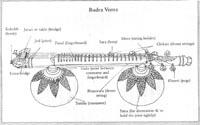
These four strings provide melody, their active length being changed during play to produce different notes.
The three strings act as drones, sounding individual notes continuously against which the melody plays. This combination of continuous melody playing against steady harmonious drones is a cornerstone of the long and close association between the two classes of instruments (the wind and the string. One drone string is often configured, by means of a special mechanism to provide an effect, the timing of which is controlled by the musician during the play. Attached to the tubular dandi are two hollow resonators made of dried and seasoned pumpkins. Rudra veena is also called as “been”. This is an instrument which can actually replicate the multiple tones of the human voice. The been or veena has always been the instrument of Indian classical music and was traditionally studied by all dhrupad students until the 19th century. Let’s see how does this instrument look like? This stringed instrument does not look like any other, veena or otherwise. It has been developed to follow the precision of Indian classical music, and the quality of the long and slow moving (vocal type) notes.
Features:
It consists of 54˝ long 22 or 24 frets made from well seasoned jack fruit, 7 strings and one piece flat bridge. The been body is a hollow tube made of Jack fruit wood, on which the strings are fixed at both ends. Bridge is flat in shape, and its length, width and height are about eight centimeters, three and two centimeters respectively. The bridge (meru) is made of stag horn or camel bone. The flat bridge increases the depth of the note’s spectrum (low frequency). The point where the strings touch the bridge is actually responsible for the tonal quality of the instrument, and thus, special care is taken to ensure that the surface does not get a mark or a groove because of the continuous pressure of the main playing strings. If this point gets abrased or grooved, the surface gets failed. This filing is called javari setting, and it is a very skilled and technical task which can be performed only by an experienced person. Traditionally the rudra veena is placed diagonally and the upper gourd rests upon the left shoulder while the lower gourd rests upon the right thigh of the player. The fingerboard is held close to the chest. Metallic frets are disposed on that tube on a slightly angled axis. They are always movable (fixed by wax or strings) and so can be adapted for every raga (the notes of the raga are not fixed by equal temperament). You will be surprised to know that to make rudra veena, makers start by growing pumpkins in field. They control the shape and size of the pumpkins. They normally require two equal sized pumpkins to make one rudra veena. When the pumpkins are small they are kept warm using blanket and a heavy weight is kept on top of the growing fruit. As a result of it the pumpkin grows sideways and makes a flat shape. The pumpkin should grow fully, then it is dried and seasoned. Most importantly the shape of the two pumpkins should be exactly same. Thus many times it happens that pumpkins do not grow in same shape, so in such situation the makers can not construct a rudra veena. Ustad Asad Ali Khan, Ustad Shamsuddin Faridi Desai, Ustad Zia Mohjuddin Dagar, Pandit Hindraj Divekar alias Digambar Shivaram Divekar and Bahauddin Dagar are recognized as extraordinary representatives of Dhrupad using rudra veena.
The Sound of Music
Suppose you pluck one of the strings of a veena. It produces sound, how does it do so? The movement of the strings on one direction pushes the molecules of the air which are just before it. This produces crowding of the molecules in that region. And when the string moves back from its original position, it leaves behind a space with less number of molecules. Meantime the molecules which were compressed or crowded together transmit some of their energy to the other molecules around them. The molecules return back to their original place, which had become less dense earlier. In other words, the vibratory motion set up by the string causes alternately in space a crowding together of the molecules of air and the emptying out of the molecules (a rarefaction). This condensation and rarefaction travels through the air as a wave. When it enters your ear you hear the sound.
The Tone of Music
One musical tone is distinguished from another on the basis of pitch, and intensity or loudness. Pitch describes how high or low a tone is and depends upon the rapidity with which a sounding body vibrates, ie. upon the frequency of vibration. The higher the frequency of vibration, the higher the tone. The higher the tone, the intensity or loudness of a sound depends upon the extent to which the sounding body vibrates, ie. the amplitude of vibration. A sound is louder as the amplitude of vibration is greater, and the intensity decreases as the distance from the source increases. Loudness is measured in units called decibels.
The Sun In Your Hands
- When the reflected image is taken up on a nearby screen, it is the same shape as the mirror. Like below figure:
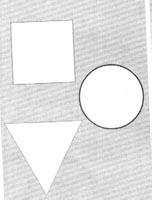
- When you take the image on a wall far away, all the images are round in shape, like below figure:
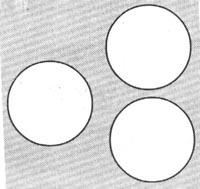
Since you are all good scientists I am sure that you must have slowly increased the distance between the screen and the mirrors and observed how the triangle and square gradually become circular.
What is this circular disc?
What happens if we use a smaller mirror, i.e. if we reduce the size of the hole in the mask covering the mirror?
Why does a smaller mirror not give us a smaller image at a long distance?
You will instantly exclaim ˝Don’t tell me the answer˝ because you will want to discover the answers for yourself. This is the real quality of a good scientist.
O.K.! So, you tell me why the image is circular at a long distance.
˝Because the mirror then behaves like a pinhole and we have a pinhole projector which projects the image of the sun˝, you tell me and indeed, you are quite right. That is why the image is a circular disc- because the sun itself is round.
By increasing the distance between the screen and the mirror you can get a bigger and bigger image of the sun. In fact, you will discover that the diameter of the image is always roughly one hundred times smaller than the distance between mirror and screen. At 100 meters, we will get a sun image which is almost one meter across. So we can use this idea to construct a powerful solar telescope and see what is happening on the surface of the sun. We can use it to see sunspots and show them to our parents and friends.
The photograph of sunspots can be obtained by using solar telescope made like this. You too can get a wonderful and exciting image of the sun, as big as you wish.
˝Can I get an image of the sun which is ten meters across by increasing the distance to one kilometre˝?
You will ask me. Yes, indeed you can, but it is not as easy as it sounds. For the greater the distance, the dimmer the image.
To see it properly you will have to create a room which is as dark as possible in which to take the image. The second thing you need is a very stable mount for your small mirror, which you can adjust carefully. Any telescope is pretty useless unless you have a good and steady amount. Otherwise, the smallest motion of the mirror will make you lose the image.

You can make a beautiful mount by buying a large plastic ball and filling it with sand. A large spherical plastic container will also do. Please don’t ask me for details about how to make a room dark, how to amount the mirror on the ball, or how to place the plastic ball in a ring, or where to get the ring, and such questions. No good scientist asks for answers to such questions. On the contrary, I expect to hear from you about how you solved the problems and did the experiment, and even a photograph or diagram of the sunspots you saw.
If you and your friends successfully do the above experiment and see sunspots, please write to us with all the details of your experiment. You will be rewarded with a prize a copy of my book ˝Measuring the Universe with a string and stone˝.
Next month we will discuss what we can discover about sunspots, the sun and our earth with our powerful solar telescope.
What does the monkey know about the taste of the Ginger?
There is a proverb that says does the monkey know the taste of ginger? But is the proverb really, really true? Does the monkey really not know the taste of ginger?
Taste perception is very important for the survival of organisms. This is because taste is one sensory organ that will prevent organisms from eating harmful substances. Monkeys and humans are both mammals and are very closely related. Monkeys and apes are also known as Primates. 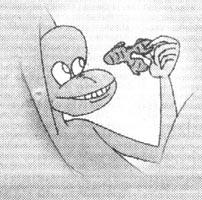
All mammals have five basic taste perceptions: salt, sweet, sour, bitter, and umami. Umami is the response to salts like mono sodium glutamate which is quite often in cooking. Tastes are sensed through taste buds that are present on our tongue. A taste bud has 50-100 taste cells that can sense the five basic tastes. When we place a substance on our tongue, the taste buds are activated and they really the information from the taste bud to the brain. The brain dos all the processing and then we realize what the taste of that substance is. The entire process occurs so fast that when place a substance on our tongue we can immediately say whether it is salty or sweet or sour or bitter. 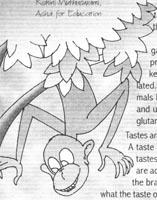
What is the taste of ginger? If I were to describe it, would say it has a bitter taste. Now scientists have analyzed the perception capacity of monkeys and humans. They have in particular asked whether both of them can taste the bitterness of eatables like ginger. And the answer that they have come up with is that: Yes! Both monkeys and humans have the same capability to taste a bitter substance. So if someone were to tell me that the monkey does not know the taste of ginger, I would say: “Oh no! Monkeys do know the taste of ginger.” Proverbs and superstitions arise because people perceive certain phenomenon in certain ways. In this case, since monkeys are supposed to be uncouth and uncultured, it was easy to say “oh what does a monkey know about the taste of ginger?” But of course it is not true, as we saw!
A long journey back home
In the fish avatar or “matsyavatar” in Hindu mythology, the story goes that a tiny fish began to grow bigger and bigger. As a child I wondered which species of fish could do such amazing things. Perhaps the fish in the ancient story was some species of salmon. The life-cycle of the salmon is a wonderful tale in itself. No other fish can do what the salmon does: it returns precisely to the stream of its birth to lay its eggs! The life of the salmon begins in a small ‘nest’ essentially a hollow swept out by the ‘tail’ of the female Salmon, into which she lays about 7,000 eggs. The ‘nest’ is called a ‘redd.’ The hatchlings from the eggs are called ‘alevins.’
A yolk sac is attached to the alevin, which contains protein, sugar, minerals, and vitamins. As the alevins grow into fry, a few centimeters long and then into fingerlings (about the size of your finger), the yolk sacs disappear. In many species of Salmon, their long journey to the ocean begins at this stage. The salmon fingerling is a freshwater fish. You might wonder how they survive the salt water in the ocean. The salmon fingerling waits in the estuary, the mouth of the river as it enters the sea, to slowly allow its body to acclimatize to changing conditions. Many salmon wait for a year before they begin this long and tiring journey. By the time they reach the ocean, they are big.
They feed on a diet of shrimp and other smaller fishes and accumulate fat reserves in their body. When the salmon are ready to lay eggs, they begin their return journey. The salmon is an anadromous fish, meaning one which begins life in fresh water, migrates to the ocean and returns to fresh water to reproduce. Migration to the ocean allows these fish to grow a lot larger than would be possible in fresh water because the ocean has so much more food.
Larger fish dominate reproductive areas and lay more eggs than smaller fish. These are advantages for the long seasonal migration of the salmon. There are five species of salmon native to the North Pacific. All of them are anadromous. All the North Pacific salmon die after spawning – providing food for predators or decomposing to release their nutrients into the stream or surrounding land. 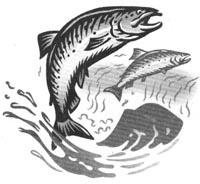
There is one species of Atlantic salmon found in the rivers of Ireland, the United Kingdom, Canada, the Faroe Islands, Iceland, Norway, Sweden, Finland, Russia, France, Spain, Canada and the United States. Like the Pacific Salmon, the Atlantic salmon too return to their homes, making an extraordinary journey of more than 4000 kms. They leap up 3 m high obstructions to reach their spawning sites! The Atlantic salmon can spawn up to three times in its life, returning to the ocean in between. None of the Pacific salmon can do this. Some Atlantic salmon never reach the sea, because they are found in land-locked lakes. These fish migrate between deep-lake feeding areas and spawning grounds along shorelines or in tributaries.
The Asian salmon is called the cherry (or masu) salmon and is classified in the same genus as the five North Pacific salmon. The Masu salmon is a Pacific salmon that is found only in East Asia. Masu die after their first spawning. Male masu salmon generally reach maturity a year after hatching. The North Atlantic salmon belong to the genus Salmo. How do the scientists know the age of the salmon? Scales cover the body of the salmon. The scales of the salmon have concentric rings. Just as in trees, these rings can be counted for age. How do salmon make this incredible journey back home? Scientists don’t completely understood how the salmon accomplishes this feat. Some scientists think that they use their sence of smell. Others feel it is accomplished by their excellent sense of vision. They can see both in front of their bodies and to the sides.
Salmon can see colours and are good at judging distances both in and out of the water. They have been known to jump out of the water to pluck a flying dragonfly out of the air. Salmon are also known to be able to see land-based predators from under the water and swim for cover. They have the ability to focus both at close range and far away and can see and interpret movement. Wild Pacific salmon are still abundant but wild Atlantic salmon are rare, mainly due to over fishing. Farming Atlantic salmon is a large industry, while Pacific salmon farming occurs at a much smaller scale. The salmon is an incredibly beautiful wild creature with several billions of history behind it. The native Americans built their lives around the salmon life-cycle, referring to themselves as the salmon people.
They believe that God became a salmon to save them from starvation. While they eat salmon as their main food, they take care to use every part of the salmon, from skin to bones. Nature is full of creatures and their delightful stories. Do think about them!
Monarch and viceroy
When I walked into the Indian store in Vancouver, Canada, and asked for sandal power Mr. Singh handed me some tablets. “They are like sandal powder,” he reassured me. “I would rather have the sandal,” I replied not wanting to buy imitations. Imitations are common in nature. They are known as mimicry. 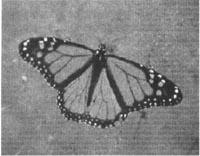 (Monarch butterfly)
(Monarch butterfly)
The Monarch butterfly, that seasonally migrates to North America and parts of Europe, and the Viceroy butterfly are two famous examples. The Monarch butter-fly was named after King William, the Prince of Orange. It is the only species of butterfly to mi-grate nearly 3000 miles. Monarch’s migration is triggered by seasonal changes in day length and temperature. Late in summer when Monarch’s temperature. Late in summer when Mon-arch’s emerge from their chrysalides (pupae), but they don’t mate or lay eggs. Instead they prepare for a long, strenuous flight southwards. In average year about 250 million butterflies migrate to Mexico! Fat, stored in the abdomen, is essential survival for the winter. As they migrate southwards, Monarchs stop to drink nectar, and they actually gain weight during the trip! 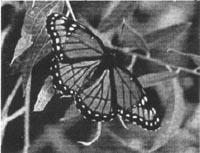 (Viceroy butterfly)
(Viceroy butterfly)
Some researchers think that Monarchs conserve their “fuel” in flight b gliding on air currents as they travel south. Monarchs are able to orient on the sun and respond to the earth’s magnetic fields. Still, no one knows exactly how Monarchs’ find their way to rare Oyamel fir forests in the MichocBn highlands, south of the Tropic of Cancer. Somehow they know their way, even though the butterflies returning to North America each the butterflies returning to North America each fall are the great-great-grandchildren of the butterflies that left the previous spring. Spring reawakens the butterflies’ reproductive organs and they mate. Females head north again to lay their eggs exclusively on milkweed plants (Asclepias) and be gin the cycle anew.
The first brood to emerge promptly lays more eggs, but when the butterflies of this brood emerge late in autumn, they are ready to migrate to warmer climates. It was once reported that a half mile long and a hundred yards wide flock of monarchs darkened the sky! When the early naturalists discovered butterflies mimicked the Monarch, they promptly named it Viceroy. Viceroy butterfly closely resembles the adult Monarchs in colour, shape, and markings. However the two species belong to different families of butterflies and are separated over large geographical area. 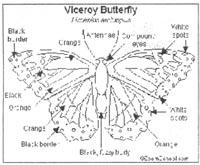
The larvae of Viceroy feed leaves of cottonwood and willow trees. The over-wintering caterpillars roll up in a leaf! Where Monarch butterflies are rare, the viceroys are brown instead of orange and mimic the queen butterfly (Danaus gilippus). Viceroy butterflies need moist, open or shrubby areas such as lake and swamp edges, willow thickets, Valley bottoms, wet meadows, and moist roadsides. Viceroys are hard to catch because it likes to land in the upper branches of cottonwoods and other streamside trees. Monarchs outnumber Viceroys when they occur together. Monarch butterflies are poisonous and the Viceroys imitate this species.
But, how do they choose the species to mimic? The mystery remains unsolved. Mimicry, a phenomenon when one species derives advantage by looking like other species, occasionally occurs in nature. There are many more out there that await discovery. Go ahead and explore your backyards!
Magic of Movies
A dark movie theatre, smell of puffs, Chips, popcorn in the air! We sit for three hours staring at the pictures that are projected on the large screen. But did you know that for part of this movie you are actually sitting in a dark theatre with no image on the screen? 
There is a projector that is located in the back of the theatre that projects the movie that you see onto the screen. There is also a very powerful light bulb in the projector that shines on the film as it passes through the projector. When the light passes through the film the image on the film is projected onto the screen. The actual movie film looks just like regular film that comes from your camera. If you could stretch out a section of film you would see a series of several still images. But how does this whole process work? If movie film is a series of still images.
Why do we see a moving on the screen? And how can we be in a dark theatre with no image on the screen without noticing? There are two simple concepts we need to know-persistence of vision and the phi phenomenon. Read on, and you will get answer to all the above questions.
Persistence of vision is the result of the tendency of the eye’s retina (the part of the eye that is sensitive to light) to retain an image for about 1/12 of a second. Peter Mark Roget first noted persistence of vision in 1820.
If you swing a lighted stick around in a circular motion you will see the illusion of a “circle” of light. This is because of the persistence of vision. Basically, if you retina sees successive images at a rate faster then about 12 per second, your eye will blend them together. This is because when you see the next image your retina is still “seeing” the previous image. This is the same reason why the world does not go suddenly pitch black every time you blink your eyes. Well, the movies that you watch in a movie theatre take advantage of this human phenomenon. Movie film moves through a projector at 24 frames per second.
That means that 24 still image (just like the images from a picture from your camera) move through the projector every second. These images move intermittently through the projector stopping for a fraction of a second on each image. When the film is stopped, the image shines on the screen. Then, the light from the projector is blocked by a shutter for a fraction of a second while the film jumps to the next image. We do not “see” the temporary darkness because we are still “seeing” the previous image. So, the time that you are sitting in a dark theatre is “ignored” by the brain. This sequence of moving film is repeated at 24 frames per second for the entire movie.
Given all this information, can you calculate the length of the reel (film) for a 3 hour movie? We know 24 frames per second are moved through the projector. That means 24×3×3600 frames in a 3 hour movie. This equals 259200 frames! Now, the only information we need is what is the length of a frame. For a 70 mm film, we have the length of all the frames equal to 259200×70!That is approximately 18 kilometers!! So, when we watch a movie, the film has to be kilometers long!
The Phi Phenomenon is simply the tendency for our brains to connect these images and give them movement. An example of this phenomenon is a series of flashing lights that we see on shops or in homes during Deepavali or Christmas. If you stare at the lights, they seem to be moving along a path. When the individual lights blink in a consecutive series, one after the other, it appears as if one light is moving along the path when actually nothing is moving at all. Our brains can do some interesting things! Isn’t t?
You can show persistence of vision and the Phi Phenomenon!
People have been experimenting with different types of things that give us the illusion of movement for centuries. One such invention is the Flipbook, which has been around for over 200 years. What you’ll need:
- A blank pad of paper
- A pencil or pen
- Colored pencils or markers
What to do:
1. Decide on an image that you want to see move (birds, planes, person).
2. Decide on the full action of the image (for example- a bird will fly and sit on a tree branch).
3. Draw the first and last image before you begin. The first image should go on the piece of paper at the bottom of the pad and the last drawing should be on the top. If your final drawing does not match the “last” image that you drew at the beginning-just remove it and through it away.
4. Start drawing from the bottom towards the top of the pad. Each image should move only slightly from page to page (you will get better at this with particle).
5. Color the images.
6. Flip the pad from the bottom to the top to view your moving image!
7. Be creative and have fun! Anything is possible with a pen and your imagination!
Bubbling With Fun
For reasons unknown, people are fascinated with bubbles. Is there a “BUBBLE-LOVING” gene somewhere in human DNA? The essential ingredient for great bubbles is good bubble mix. Here are two methods that have given good results.
Method 1
1 part water, 5 parts dish washing liquid detergent, 2 parts glycerine. Optional: you could try adding sugar 1 cup/5L bubble mix.
Method 2
6 cups of water, 2 cups of clear dish washing liquid detergent, 3/4 cup of white corn syrup or starch solution (cooked). Mix this for 4 hours before using.
Tips for brilliant bubbles:
1. Prepare your bubble mix in advance. Older solution gives better results than the fresh solution.
2. A bubbles worst enemy is a dry sunny day. The best kind of weather for bubble is humid and cloudy because the moisture in the air will stop the bubbles from popping so quickly.
3. Bubble mix and eyes do not mix! If bubble mix does get into someone’s eyes it will sting. Rinsing the eye throughly with water should provide some relief. To make sure that every one washes their hand after a bubble making session.
So you have got a cloudy humid day and some bubble mix but what to do with it? It’s time to get out there and blow some bubbles! Of course what you use to blow these bubbles is another matter entirely. Plenty of interesting bubbles can be bought from toys shops but making your own is cheaper and more fun.
You can use steel wire, the wire can be bent into whatever shape you like. Other great bubble makers include plastic straws, hollow leaf stalks from papaya and many other trees. kitchen utensils such as spatula with holes.
Bubble trumpets: Cut a plastic bottle about 2/3 of the way up the bottle- now you have a bubble trumpet. Dip the cut end into the bubble mix and blow through the screw top; it results in making beautiful bubbles.
Hands in: Blow a large bubble; now get someone to try putting their hand in. The bubble will usvally pop because hands are quite dry. If the person dips their hand in bubble mix and tries again they should be able to wiggle their hand about inside a bubble. 
Bubble snow: To make bubble snow (hundreds of tiny little bubbles) all you need is bubble mix, a kitchen strainer and a quick flick of the wrist. What shape bubbles do you get from different shaped bubble? Does a star shaped bubbler make star shaped bubbles? Infact, the bubbles will always be sherical because soap films are lazy and like to take up the smallest shape possible. This is due to the surface tension of soap film.
There are heaps of things that you can do with bubbles, write to Jantar Mantar, if you found new trick to make something out of bubble mix. Happy bubbling and do not forget to clean up.
Monsoon
Mid-May, it is hot and humid in the Southern part of India. Everyone is longing for cool rainy days which is due any time. It is the beginning of monsoon season in India. Newspapers are already talking about approaching rains. Weather department is busy predicting date of onset of monsoon over the Southern tip. 
TV commercials in Kerala are in full swing with ads on different makes of umbrella. Start of monsoon season there usually coincides with the reopening of school after the summer holidays. The word monsoon appears to have originated from the Arabic word “mausim”, which means season. It is a term originally coined by Arab sailors in reference to the seasonal reversal of wind direction in the Indian Ocean and surrounding regions, including the Arabian Sea. These winds blow from the southwest during summer months (mid-June to October) carrying copious amount of moisture from the ocean. As a result southwest monsoon causes very heavy rainfall in many parts of the country. It plays an important role in shaping our economy, as agriculture is heavily dependent on these seasonal rains. In November (till February),dry air from the interior travels to the ocean, causing the dry cool weather of the retreating northeast monsoon. By the beginning of November, retreating monsoon withdraws from northern plains. They form a period of transition from hot rainy season to dry winter condition. Retreat of monsoon is marked by clear skies. Land is still moist. In Northern India mercury begins to fall rapidly in second half of October. The winds from the northeast during these months are dry because they have lost their moisture. As these winds approach the Southern tip of India, the location of the state of Tamil Nadu, they do pass over the Bay of Bengal and pick up moisture.
Tamil Nadu then receives most of its rainfall during these months. Monsoons, however, are not just an Indian phenomenon. The monsoon season happens in countless other places, notably in Southeast Asia, Australia, some parts of Africa and many locations in North and South America. The large areas involved in monsoons and the grand scale of the weather within monsoons suggest that they play a significant role in modulating global climate. For centuries, people have tried to understand what causes the Indian Ocean monsoon to arrive each June and die down each October. Scientists say that the two key factors needed to make a monsoon are a hot land mass and a cooler ocean. In India, for instance, the land absorbs heat faster from the Sun than the surrounding Indian Ocean does. This causes air masses over the land to heat up, expand, and rise. As the air rises, cooler, humid, and heavier air from over the ocean will replace it. Over India, this damp, cool layer can be to three miles thick. As the cool air arrives, the winds also shift. During the dry season, the winds blow offshore, from land to sea (northeast). Then, as the monsoon begins, the winds blow on-shore, from sea to land (southwest).In the case of the Indian Ocean monsoon the differential heating between the land Ocean, and heat changes associated with water vapour transforming into liquid produce more intense effects than any other place in the world.
How do I make clear ice?
How do I make clear ice like they have in restaurants? I use distilled water but the cubes have hundreds of tiny bubbles in them. The best way to answer the clear ice question is to think about icicles. Icicles are normally clear and beautiful. There are two things that make icicles so perfect. Icicles are made from pure water in the form of melted snow. It is therefore important to use de-mineralized water. Icicles are created in layers. Water drips down the icicle and freezes in progressive layers rather than being frozen all at once. This approach avoids the entrapped bubbles. If you ever look inside a restaurant ice maker, you will find that it makes ice in layers as well. Cold water runs continuously over a plate or a grid where the ice is forming, and the ice cubes (or ice disks in some machines) grow in layers.
Why is southern exposure so sought after when searching for a house in any city?
The Southern exposure is important in any city in the northern hemisphere, particularly for those living in latitudes north of the tropic of cancer, if one wants to take advantage of solar energy. This happens because the earth is a sphere and spins on an axis that is tilted 23 degrees. It is easiest to understand why sun comes in your southern – facing windows by looking at how a house sits on the planet and how the sun shines on the house in summer and winter. The two diagrams above help you see what is happening:
You can see that, both in summer and winter, the wall of the house that faces the South pole is the one that faces the sun. In these diagrams you can also see that the apparent angle of the sun to the house changes in summer and winter. In the summer the sun is much higher in the sky:
Is there an equation to work out……..
Is there an equation to work out how for away the horizon is when you are standing on the beach, based on how high your eyes are above sea level?
One of the funniest things about the ocean is the fact that its surface is curved! We tend to think about water forming large flat sheets, but the surface of a large body of water actually is not flat at all – it follows the curvature of the earth.
Because of the curvature of our planet, the distance you see when you look out at the ocean depends on you height above the surface of the ocean. The following diagram shows you how the distance of the horizon can change depending on the height of the observer:
So the distance of the horizon depends on the height of your eyes above the water. If your eyes are 8 inches (20 cm) above the water, the distance of the horizon is about one mile away (1.6 km). A rough formula for calculating the distance to the horizon is: Height above surface /0.5736 = (Distance To Horizon)2
Where Height Above Surface is in feet and Distance To Horizon is in miles. If you are 6 feet tall and standing right at the water’s edge, then your eyes are about 5.5 feet above the surface.
The distance to the horizon is: 5.5/0.5736 = (3miles) 2
In metric the equivalent is: Height Above Surface /6.752 = (Distance To Horizon) 2 Where Height Above Surface is in centimeters and distance To Horizon is in kilometers.
When I dive down, my ears start hurting……? My ears never hurt when I am swimming on the surface. But when I dive down, my ears start hurting. What causes them to hurt?
If you have ever stuck your finger into your ear, you know about the ear canal. The ear canal is a tube, and at the end of the tube is the eardrum – a then piece of skin stretched tight like a drum over the end of the ear canal.
On the other side of the eardrum is a hollow space filled with air called the middle ear. What you want is for the air in your ear, canal and the air in the middle ear should have the same pressure. If they do then the eardrum has equal pressure on both sides and it is smooth and happy. In order for the middle ear to equalize its pressure, there is a thin tube called the Eustachian tube that connects the middle ear’s air chamber to the throat. Air can flow back and forth through the tube and this keeps the air pressure in the middle air equal with the outside air pressure.
When you swim in deep water, there can be a lot of water pressure. At sea level, the air’s pressure is 14.7 PSI. Each foot of water creates water pressure of 0.43 PSI. So if you swim in 10 feet of water the total water pressure is 4.3 PSI. Add that to the air pressure of 14.7 and the total pressure at the bottom of the deep and is 19 PSI.
If your Eustachian tube is clogged or narrowed for any reason, then your middle ear gets shut off and becomes a closed chamber. It holds air at 14.7 PSI. When you swim to the bottom of the deep end the water is pressing into the ear canal 19 PSI, so the ear drum bows inward because of the pressure difference. Since the ear drum is full of nerves, you feel this bowing as pain.
Ozone is good or bad?
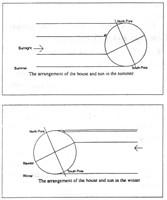
I keep hearing about ozone being “bad” in the context of pollution in the city. But then you hear about the ozone layer and it is “good”. How can ozone be both good and bad? The thing that makes ozone both good and bad is its location. Ozone is “good” When it is in the stratosphere. The stratosphere is a layer of the atmosphere starting at the level of about 10 kilometers above sea level, the stratosphere naturally contains about 6 parts per million of ozone is very beneficial because it absorbs UV radiation and prevents it from reaching us.
At ground level, ozone is “bad”. Ozone is a very reactive gas that is hard on lung tissue. It also damages plants and buildings. Any ozone at ground level is a problem. Unfortunately, chemicals in car exhaust and chemicals produced by some industries react with light to produce lots of ozone at ground level.
What is plywood? Why do people use it so much?
The advantages of plywood include: Its size (4 feet x 8 feet is the common size). Its low cost for the size Its strength Its stability – warping and shrinkage is much less of a problem. Its plywood did not exist; you would end up making the same size piece of wood from a collection of flat boards. That approach would be a lot more expensive and would not be nearly as strong or stable. To make plywood, a log is softened with steam and then mounted on a lathe. A long knife peels off a thin layer of wood in a continuous veneer sheet.
Once dried, a thin veneer sheet like this is very strong in one direction (along the grain) and very weak in the other (across the grain). To make plywood, several layers of veneer (generally 5 or 7) are layered together with the grain direction alternating between the different layers. Flue is used between the layers and the stack is heated and pressed to form a rigid panel. Because the grain direction of the layers of veneer alternate, the panel is extremely strong in all directions.
Why do bananas turn black if you put them in the refrigerator?

Bananas turn black even if you leave outside for a long time. This is due to dehydration- loss of water from the fruit. The blackening process is speeded up in a refrigerator. Fruits and plants “breathe”- they let out and absorb air, in the process, moisture. In a fridge, the moisture let out from the fruit rises and condenses near the freezer due to the cold. The air becomes drier, causing more moisture to be breathed out. The bananas dehydrate faster and turn black.
How are stripes put into toothpaste?
Toothpaste tubes are normally filled from the flat end at the bottom, which is then folded over and sealed. To create stripes, a special device is fitted inside the main tube, near the nozzle. – Something like a tube within a tube. This device is couple of centimeters long and has a ring of holes at the top, leading to the nozzle (see picture). Suppose the toothpaste is white with red stripes. Initially, the red part is filled so that it fills up the device near the nozzle. Then, white paste is filled into the tube. When you squeeze the tube, the white paste comes out through the hole in the centre of the special device. At the same time, the white paste pushes against the red paste and forces it out through the ring of holes in the special device. The holes in the inner device are designed so that when two streams of paste come out of the tube, they are arranged in a white and red striped pattern.
How does milk sold in cardboard cartoons stay for six months without boiling or refrigeration? P. Hareesh, Mumbai
Louise Pasteur discovered that milk gets spoilt because bacteria in the atmosphere get into the milk and make it Ferment. Boiling destroys these bacteria and refrigeration slows down fermentation. Pasteur discovered a process called pasteurisation in which milk is heated for a long period, killing almost all the bacteria. Milk sold in cardboard cartons milk is first pasteurized and then sealed in vacuum. Hence there is no air in these cartons to introduce fresh bacteria into milk. However, since even pasteurized milk contains some bacteria, it will spoil after some months.
Why do sea water fish die if they are put into the river?
K. Sriram, NanganallurRiver water is much less salty than sea water. The concentration of salt on a fish’s body is in between that of river water and sea water. This gives rise to a process of osmosis through the membranes of the skin-water diffuses from an area of lower concentration to an area of higher concentration. Hence fresh water fish tend to absorb water from the river while sea water fish lose water to the sea. The kidneys, gills and skin of a fish play an important role in checking the effects of osmosis, enabling the fish to live. The kidneys of fresh water fish excrete much more water and the gills and skin are specially developed to absorb a lot of salt. In sea water fish the kidneys and gills excrete a lot but very little water. When a sea water fish is removed from its natural environment into a river, this balancing act of nature goes awry and the fish at once loses salt and retains much more water causing death. However these are some fish like salmon whose physiological processes adjust to this reversal of osmosis flow and hence can they can travel between fresh water and the sea.
Why do we sweat in summer?
Human beings are warm –blooded- the temperature of the body is maintained almost constant all the time. In summer the body gets heated and to cool down it sweats- water is pushed out through the pores. Sweat evaporates from the skin and cools down the body.
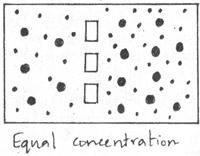
Why can we feel our pulse only at certain points along our body, like the wrist?
Our pulse is a result of the pushing action of the heart. The heart pushes the blood into a big blood vessel called the aorta. The aorta Branches out into a network of blood vessels called arteries which carry blood to all parts of the body. Arteries have elastic walls.
Each time the heart expands and pushes blood in to aorta, the walls of the aorta expand. This expansion travels along the walls of the aorta to the other articles in a wave. Thus, as the heart expands and contracts, the walls of all the arteries in the body also expand and contract. This expansion and contraction of the arteries’ walls is what we call the pulse. All arteries have a pulse, but we can feel it only along arteries which lie close to the skin, such as at the wrist and at the side of the neck.
The Games of Chance - SNAKES AND LADDERS
Dr. Abhijit DeshpandeGames can be of very different types. For example, there are outdoor games, involving athletics and balls. But what about during the summer vacation? With the scorching heat of the sun, indoor games take on an added attraction. Getting together with brothers, sisters, cousins, friends, and even elders at home! Nothing like spending an afternoon playing board and card games, isn’t there?
Strategy and Chance
Why do we enjoy these games? Well, because we all have a “chance” to win. An element of chance makes a game very interesting. You have to use your knowledge about different possibilities, decide on a strategy and play. Backgammon is an excellent example; even though a match between good players may be decided by the favour of the dice, a good player will almost always defeat a poor player. The same goes for many card games such as Bridge or poker. These games also call for thinking of the highest level.
Games of chance
There are games in which an element of chance is decisive, such as in Snakes and Ladders or roulette. In these games, everybody is equally likely to win. There is no strategy that you can follow to play better. For example, in snakes and Ladders, eventually everybody will reach the final square. The winner is just the person who reaches the last square first. In fact, much of the popularity of this game comes from the fact that there is no “better player” and that everyone has a similar chance to win. If you lose it doesn’t matter much because you may win another time. That’s the attraction of this game! Let’s look at Snakes and Ladders more closely. (We will discuss games that include an element of strategy as well as of chance in another Jantar Mantar issue.) Can we make it more exciting, and, somewhat different? 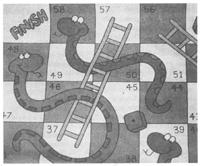
The origin of snakes and ladders is found in documents from India around 2nd century BC. It is said that it was used as a game for teaching morals. The British took it to England in 1890s and from there, it spread to the rest of Europe and the world. See the accompanying figure for a handmade Snakes and Ladders game from Bangladesh. When was the last time you played snakes and Ladders? Do you think this game is appropriate only for youngsters or do you play it with older people as well? Well, here is a chance to play with any one like! Look for the board in the centre spread of this issue of JM. Now follow the instructions and simply play!
Make your own board
The first step is to cut out some squiggled snakes and some ladders of different lengths. How do we choose the length? By the size of the board, of course. Look at the board on the centre page. Make a few snakes and ladders roughly half the size of the board (that is, to cover 4 to 6 squares). Make one really long snake or ladder (that will cover eight or nine squares) and a few short ones. Now, place them at different inclinations so that they are tilted at different angles to the horizontal. A flatter snake or ladder brings you down or up fewer squares. You can even make a snake or ladder totally horizontal. Make sure that the head of the snake lies on a large number than its tail. After making the snakes and ladders, we need to stick them on the board – but where? Note that it is impossible for two ladders or snakes to start on the same square. However a snake’s tail may be at the head of another snake, or at the bottom of a ladder. This means that you could ride one snake down to its tail, and immediately have to ride the next snake; or ride a snake down to its tail and immediately climb a ladder.
All in one turn! The length of snakes and ladders, and their positioning, decides how easy it is to reach at least square (100, most of the time). So, here is the stick. We can count how many squares are gained by ladders on the board, and how many squares are lost by snakes. The ratio of these counts will tell us how easy it is to reach 100. In the board from Bangladesh (see the figure), 225 is the total number of squares lost by snakes and 122 is the total number of squares gained by ladders. So, we can add more ladders, so that the number of squares gained and lost is equal. But if we put many more ladders and that too longer ones, we will take very little time to finish. That is all. Simple, isn’t it! Why don’t you do it and see the effect? Go ahead and play! Put as many snakes and ladders on the board as you like and try to make predictions.- Try to make: a fast game, or a slow game, or a good game.- Don’t forget to explain why you think your game will be fast/slow/good.- Try out your game and test your predictions.
Different Ways :
As we said earlier, Snakes and Ladders is a game of pure chance. But we can make it interesting by changing the rules. Also, we can try to modify rules so that we have to use some strategy to win. For instance, play with two dice.- you can sum both the dice and move your coin up.- you can use one of the dice to move your coin up and the other to move your opponent’s coin down. This way you can think of a number of possibilities and decide on a strategy. You have to be careful in observing how close you and your opponent are from a ladder and a snake otherwise you may end by pushing up your opponent instead of bringing him down!
Question: What’s so hot about fractals, anyway?
Answer: They’re new!
Introduction :
Most math you study in school is old knowledge. For example, the geometry you study about circles, squares, and triangles was organized around 300 B.C. by a man named Euclid. Fractal geometry, however, is much newer. Research on fractals is being carried out right now by mathematicians. (Have you ever thought about a career as a mathematician?)
Much research in mathematics is currently being done all over the world. Although we need to study and learn more before we can understand most modern mathematics, there’s a lot about fractals that all of us can understand.
Fractals were discovered by IBM scientist Benoit Mandelbrot while studying geometrical objects like structure of a coastline and lighting flashes. Many objects in nature aren’t formed of squares or triangles, but of more complicated geometric figures. Many natural objects – ferns, coastlines, etc.- are shaped like fractals. 
Think about the long coastline of India. How long is it really? Suppose you measure it with kilometre-long rulers and get a certain measurement. What if on the next day you measure it with meter-long rulers? Which measurement would be larger? Since the coastline is jagged, you could get into the nooks and crannies. It would be better with the meter-long ruler, as it would yield a greater measurement.
Now what if you measured the length of the coastline with a centimetre-long ruler? You could really get into the teeniest and tiniest of crannies in the Bay of Bengal or in kutch! So the measurement would be even bigger, that is if the coastline is jagged smaller than a centimetre.
What if it were jagged at every point on the coastline?
You could measure it with shorter and shorter rulers, and the measurement would get longer and longer. You could even measure it with infinitesimally short rulers, and the coastline would be infinitely long. That’s what is meant by something being fractal in nature. 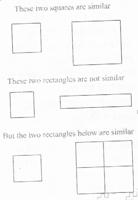
Fractals are self-similar. Cats, canaries, or Kangaroos are similar if they are alike in some way. In geometry though, similar means something very specific. Geometric figures are similar if they have the same shape. I don’t mean any two triangles, but really the same shape. 
For example: Look carefully at the last rectangle and you will see that it is 2 times as wide as the one on the left and 2 times as long. We say that the sides are in proportion and the ratio is 2:1. Since the corresponding side are in proportion (and the corresponding angles are also of equal measure), the figures are the same shape and are similar.
Consider similarity in another way. In order for one figure to be similar to another, you must be able to zoom in on one of the figures, and it will look exactly like the other one.(Of course you might have to rotate it or flip it). You can think of self-similarity as copies. For example, the figure below is got by taking a line and putting a triangle in the centre. The lines on this figure are marked by solid dots at the end points.
Kock’s snowflake fractal :
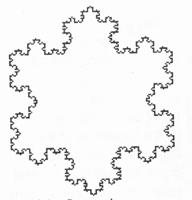
This is because the repeated additions (called iterations) of triangles on each line of the figure gives a pattern that looks just as a snow-flake would, under a microscope. Why don’t you draw at least three iterations of this figure and see what you get?) So you can see that three are two important properties of fractals: they are self-similar, and they can be formed by iteration. There is one more mathematical aspect of fractals that in fact gives them their name: they have fractional dimension. This is a very unusual concept and we will discuss this later, in another issue of JM.
Make your own fractal.
Here’s how to make a “Jurassic park” fractal simply by paper-folding. The name of the fractal comes from the fact that some of the iterations of this fractal were used in the famous book called Jurassic park. 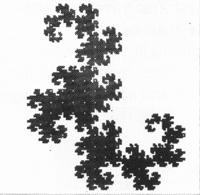
Take some (preferably stiff) paper. It should be able to hold its shape reasonably when folded. Take a strip about 2 cm by 30 cm. The iteration procedure is very simple. The first iteration just folds the paper in half. Then open it up so that it looks like this: That is, the angle at the fold is 90 degrees. The next iteration Start afresh. Fold the paper in half. Then, fold it gain in half. Make sure the creases are sharp and well marked. Before you open the paper out, can you imagine what it will look like unfolded? Let’s unfold and see. 
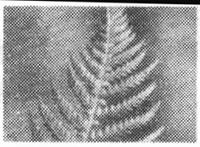
Whenever there is a fold in the paper, remember to make the angle 90 degrees in the same direction as the fold. That is, don’t ever change a “down-fold” into an “up-fold”. Just open it up until the angle is 90. Do you get this shape? What is the third iteration? Just fold the paper strip three times. Fold it in half each time. Then open up the folds into 90 degrees angles. Here it is (on the left):
Can you fold the paper 4 times so that you get the fourth iteration shape shown above? Make sure you’ve got that closed-up square. You may have to rotate your paper to get the exact matching. The shape is getting interesting, isn’t it? If you start with a longer strip of paper and fold really carefully, you’ll be able to get more complex structures at the fifth and sixth iterations. The seventh iteration is hard to do by paper folding, but you can see the little dinosaur beginning to from! The 50th iteration on the same page shows it up clearly. Can you see (from the shading) how the repeated iterations result in a self-similar structure? Can you find other such examples of fractals? Do send them in to us at the JM address given on the last page.
Fractals in nature :
You stroll through a shady forest. Tree trunks like pillars rise to the canopy of branches in the sunshine. You glance down. At your feet a fem arcs across the winding path- its structure is very fractal. The featherlike frond of the fern is composed of rows of smaller fronds, and the smaller fronds have their rows of even smaller fronds, too. If the whole fern can be said to be the expression of the living plant’s “self,” which organizes itself in a coherent pattern, then the kindred parts of the plant are “self-similar”– they are like each other and like the whole. Trees branching, rivers meandering, clouds gathering puffs made of puffs, lighting zigzagging, insects whirring and birds wheeling in the sky … flames leaping, wind coursing through space, soil and sand grits in aggregates joining together, metal fracturing, earthquakes rending … all trace fractal paths through space and time. Processes in lungs, bile dust system, bowel and kidney, in the neural networks of the brain, in the placenta and the heart, in the ways we walk and talk, are full of fractals. Fractals of vision- cones and rods and branching nerves- show us order.
The Bewitching Insect World
Dr. S. Srinivasan, CD, IGCARThe Kalpakkam Township and IGCAR campus abound with rare species of insects and birds.
One such species worth observing is the rd plant bug called Iphita Limbata. Some wood-leach and butterfly also inherit this striking colour combination of red and black. The body of this insect is decorated with triangular pattern of black colour. Its body could easily be covered with the size of a fifty paise coin. These bugs are primarily diurnal (day time wanderers) and are not a pest of any great significance of commercially important crops. Unlike the very familiar red cotton bug.These insects are hexapod a (six legged) arthropods (having jointed legs). They are most abundant and widespread of all land animals. Over a million insects have been identified and named. Many scientists believe that three could be as many as two to three million other species yet to be discovered. Our hero namely the adult phytophagous bug, Iphita Limbata is deep red in colour and it is flightless. These bugs possess a black scutellum, membranous part of the wing and the antennae. The feelers (antennae) are unique coloured and segmented. The terminal segment of the antennae is pale yellow in colour with the second and third segments black and the basal segment being red. All six legs are red in colour. The tarsal bristles are black. They have sucking type of mouth parts, forming a piercing proboscis. These insects have conspicuous eyes but lack ocelli and show sexual dimorphism. 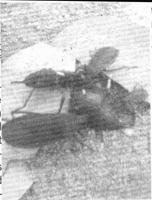
Iphita Limbata is usually inhabited where abundant vegetations of herbs, shrubs, trees, twiners, climbers and runners are seen. Though they are found to be moving around, wandering about and hiding among the green vegetations, only a few plants serve as hosts. These insects take rest in teak trees, almond trees (baadaam trees) and Indian ash trees. During warmer season, the insects are found in large numbers on twiners and runners near the ground level. They prefer an optimum temperature and high relative humidity to thrive and flourish. These insects feed on wild almond fruits, plant seeds and plant sap.
The males are smaller and have narrower abdomen than of the females. The gravid females show remarkably extended abdomen. Besides these, sexual dimorphism is evident from the external genitalia like the aedeagus in the males and ovipositor in the females. During copulation, the male that is smaller and lighter covers the female and twists its abdomen and tries to bring its posterior part nearer to the corresponding region of the female. The male than produces and inserts its aedeagus into the vagina of the female and gets locked immediately. Now the male turns back so that the two insects have their heads pointed in opposite directions (such as the sight one might have noticed at dog’s mating seasons).
During the process of copulation, both the individuals continue to feed and move. If the pair encounters some obstacle on the way they have the ability to move laterally also. The female that is larger and stronger determines the direction of movement and practically drags the male along. If left undisturbed, the mating generally lasts uninterrupted for a period of about three to four weeks. During this period, the abdomen of the female begins to swell up as the eggs inside grow by deposition of yolks. Towards the end of this period, the female appears ‘fully gravid’ with a considerably swollen abdomen.
Oviposition is marked by a conspicuous ‘pre oviposition behaviour’ on the part of female. She taps the abdomen and the legs of the male repeatedly at rapid, regular intervals with her hind legs. An occasional pulling out of the abdomen as if to disengage the male also be seen. This tapping would last from one to two hours. 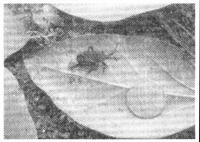
Once the pair separates, the female avoids the male, though he may try to copulate again. After separation, the female becomes quit restless and begin to move about slowly searching the surrounding regions with the trip of the lowered antennae. The trip of the rostrum is also used in reconnoitring the sites.
This ‘pre oviposition behaviour’ lasts for about two to five hours. Towards this phase, the insect seeks a tight corner, often with the crevices and debris of leaves and twigs. On finding a suitable spot, it protrudes the posterior part of the abdomen and thrusts it into the soil or the crevices. With the abdomen kept downwards and the head elevated above the ground, it starts laying eggs. The total number of eggs laid varies between 100 and 150.
Usually the egg laying process takes place during night. When the oviposition is completed, the female covers the eggs with soil and bits of small dry leaves with the help of its legs. The eggs are oval in shape and white in colour. They measure about 1.3 to 1.9 mm in diameter. They turn dark yellowish or orange colour just before hatching. The eggs hatch within seven days after oviposition and a new generation of bugs emerge and the life cycle repeats. I acknowledge my sincere thanks to my friend Shri S. Janarthanan who culled out valuable information about this insect. He is a post-graduate teacher in Zoology at Government Higher Secondary school, Thirukkazhukkundram.
He met a number of entomologists in Christian College, Tambaram and Loyola College, Nungambakkam to gather information on this plant bug- Iphita Limbata. My thanks also go to, my son Shri S. Subramanian who followed the insects in their natural habitat and captured them into visual frames of lasting value.
Organic Agriculture
To understand agriculture we should first know how plants grow. Just as we need food to grow, plants also need food. And of course. Water and air. However, plants are different from us in one very important way: unlike us who eat other living organisms for food, plants make their own food.
We all know that green plants synthesise carbohydrates (energy giving food) from the carbon-dioxide in the air using sunlight as energy. This process is called photosynthesis.
However, plants also need other nutrients. These nutrients are got from the soil in which the plant grows. The nutrients are formed in the humus, which is formed by decayed plant and animal matter that makes up good soil. (To find out what “good soil” is, see the box below.) And since plants get all their nutrients from the soil, the soil should have a good balance of all the basic nutrients that the plants need. When this is the case we say the “soil is fertile”. The most important plant nutrients are nitrogen (N), phosphorous (P), and potassium (K). There are also other micronutrients (more than a dozen of them) that the plants need. 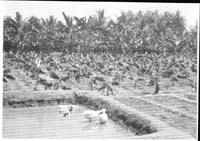
Every time a crop is harvested, a considerable quantity of nutrients that were absorbed from the soil to form the grains or fruits or leaves are removed from the soil. In other words, by harvesting, what we actually do is to harvest the nutrients from the soil also. Unless this is put back into the soil, the soil will get depleted of these nutrients and naturally the crop yield will come down. If you replenish the soil with a supply of nutrients after every harvest, the nutrient balance of the soil will remain constant. In other words, the agriculture will be sustainable and also the crop yield.
This compensation of nutrients can be done in two ways: either by adding chemicals in the form of synthetic fertiliser to the soil, or by adding organic or natural fertiliser. In general, crops need not only water and nutrients but also other inputs. For example, like human beings, crops also can get diseases. Or crops may get attacks from pests just as human beings are affected by disease-causing organisms such as mosquitoes, viruses etc. If all the inputs given to crops are organic in nature, one can roughly call it organic agriculture.
Organic agriculture is a system of agriculture which can be technically defined as that where “a number of mutually beneficial interrelationships between various plants and organisms play a vital role for a sustainable agricultural system!” That sentence was thoroughly confusing, I am sure. Well, let us look at the words prey on other harmful insects and so help the plants. For example, mealy bugs and scale insects are naturally controlled by lady bird beetles.
Spiders and dragonflies in the paddy fields also control pests. Rat snakes control the field rats! It is also possible to choose cropping patterns such that no major pest is allowed to infest any one single crop. 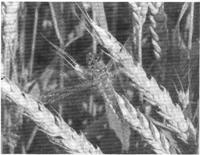
For instance, two or more crops can be grown together, in which one crop will keep the pests of another crop away due to its repellant qualities. Another way is the growing of different types of crops (multi-cropping system) which coexist harmoniously and exchange nutrients amongst each other. Or there can be crop rotations in which the nutrients left over by one crop in the soil are trapped by a following crop which again is following crop which again is following crop which again is followed by different crop. 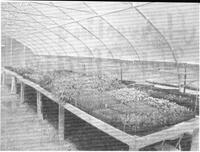
There are numerous such interesting crop inter-relation-ships in which no external inputs are required. Much of the left over after which the crop is harvested is put back into the soil since these residues will contain the nutrients which the crop has taken from the soil. So we see that it is possible for all the inputs for agriculture to come as organic or non-synthetic ones. But how do we compensate the soil nutrients so that the crop yields are not affected? And how do we control the pests and weeds by not using chemicals? Farmers have over long periods of time evolved many interesting strategies to overcome this. We shall describe this in the next part of this article, in the next issue of JM.-T.P.
Rain Harvesting- Simple yet Effective
Rainwater harvesting is one simple method of overcoming recurring drought or scarcity of water in all parts of India. The idea is easy to implement and the coasts are minimal, but the benefits are enormous.
This is particularly true for a monsoon dependent country like India, where the rainfall is heavy in certain areas during specific periods of time only and is known to fail occasionally. The basic idea in harvesting of rainwater is to direct all excess water during the monsoons to a specific area for storage or to recharge the ground water in the underground aquifer. 90% of the rainwater during the monsoons flows down the slopes to the nearest rivulet and finally to the river and the sea. Very little water goes to recharge the diminishing ground water levels in your immediate neighborhood.
Due to the increasing number of bore wells and wells in the cities, the ground water levels are rapidly sinking whereby such supplies become unreliable just like the city/town corporation water supply. In fact, in cities and towns on the coast, the sinking water table actually will cause sea water to enter the aquifer and contaminate the fresh water supply and the existing soil. The main idea is to try and divert the flowing water to recharge the ground water in the ground close to the existing wells or bore wells. All the rainwater is directed to flow into specifically located areas within the boundaries of the property, so that it soaks into the ground with the best possibility of recharging the ground water supply immediately below the property. This water can be used to recharge the existing wells/bore wells, displace the hard ground water and provide suitable water for drinking and other purposes. This method involves some simple surveys and a few strategically located sink-holes to direct all rain water flowing out into the ground itself. The costs and implementation of the system are minimal. The other rooftop water harvesting involves directing all rooftop rainwater to an underground tank, passing through a simple filter like a block of lime and into the cistern or reservoir. Some cities like Dwarka and Chennai have adopted this method effectively. 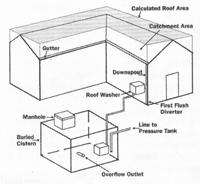
In fact, some city corporations are making rainwater- harvesting compulsory for all new schemes and projects. If properly designed and used only for cooking and drinking, rainwater stored in underground tanks can last up to two years. This can be used as a supplement to the regular city water supply, hence saving some costs. Water harvesting assumes greater importance in India, a country overstretched in terms of money and infrastructure. With rising costs and population, these methods can be adopted profitably in both urban and rural areas. In fact, roof top water harvesting system must be made compulsory for all new buildings in all towns and cities in India, and encourage this in the existing buildings also. The final harvesting method is check dams. These are small bunds or dams, built in strategic locations in rivers and lakes, that can hold both rain and river water.
So water which would normally just flow away to go to waste unused into the ground. If well located and properly built, these dams can store water and help prevent scarcity for a major part of the year. If well designed and constructed, these need little maintenance, unlike large dams, which have other major problems like seismic issues and displacement of people. In some districts of Rajasthan, these methods have made people self-reliant and provided them relief from the vagaries of the uncertain monsoons.
In fact, these simple techniques have provided water for some villages with water throughout the year. The method is very cost effective and easy to plan and implement throughout the country.Unfortunately rain harvesting, as an effective tool to over-come drought and water shortages in India, has not received sufficient attention from the government and NGOs. The state authorities must take the lead and encourage the city and town planning departments to increase awareness of rain harvesting and make it mandatory for all new buildings and projects.
The municipal corporations must make it part of the process of planning and development in the cities and towns. This will encourage conservation of water and enhance the water supply automatically. Bangalore, Chennai, Pune and New Delhi corporations have already taken the lead in encouraging rainwater harvesting. States like Rajasthan, Gujarat, Karnataka, Tamil Nadu and Maharashtra have also provided the initial impetus in this respect. This will go a long way in alleviating the water shortage situation in most Indian cities and towns.
Animal Scales
Animals come in all kinds of shapes and sizes, but why are they the sizes that they are? Why don’t we find ants as big as elephants? (Imagine the size of the anthill.) Why are there no land animals as big as some whales? The answer turns out to depend on simple Maths. 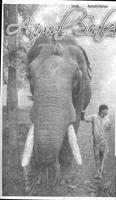
First, let’s tackle a topic a little closer to home- giants. Despite all you may have heard about Beanstalks, giants would have a hard time managing on earth. Let’s see why. First off, take a tall man, 2 meters in height, 100kg. This man isn’t a giant, so let’s scale him up 10 times. Now he’s 20 meters tall- a very respectable giant. How much does he weigh? 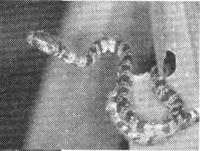
The first answer is 100×10 = 1000kg, but we need to slow down. If we had just made this man 10 times taller, without changing anything else, then he would weigh 10 times as much. But that would be a strange-looking man-more like a stick than a man. If a giant has the same shape as a man, we’re going to need to expand his other directions- back to front and side to side- by the same factor of 10.
Thus, our giant is 10 times taller, 10 times wider, and 10 times thicker. So how much does he weighs? Starting with 100kg, we scaled his height by a factor of 10. That certainly multiplies his weight by 10, for 1000kg. Then we made him 10 times thicker. That’ll scale his weight by another 10, for 10,000kg.
Finally, we made him 10 times wider. That makes another 10 to scale, and 1,00,000kg. In other words, scaling our man by a factor of 10 actually scaled his weight by 1000.
So our new man is 20 meters tall and weights 1,00,000 kg. What’s the problem? Let’s examine his leg bones. It’s easy to see that the length of the bones is not going to affect their strength, it’s how thick they are, or in other words, what their surface area is (when you’re choosing a study chair, do you choose one with longer legs, or thicker legs). Let’s say the original man and legs with a cross-section of .5 square meters (so that if you sliced his legs off and measured their thickness, together they’d be half a square meter, grisly as it sounds). Marketing him 10 times taller doesn’t change his legs’ thickness. Scaling back-to-front by 10 does make his legs 10 times thicker back-to-front, and similarly for side-to-side. 10 × 10 = 100. Thus, even though the man has been scaled up by 10 in all 3 directions, the legs’ thickness has only been scaled in 2 dimensions, since the thickness is, in some sense, 2-dimensional. So the 5 square meters originally has become 50-square-meter-thick legs.
Sounds fine, no? Expect that before, we had a ratio of 100kg: 0.5 sq.m = 200 kg/sq.m, and now we have 1,00,000 kg: 50 sq.m = 2000 kg/sq.m. This means that each bit of leg surface area has to support 10 times as much weight- the area has increased by a factor of 100, but the weight has increased by 1000, so this is expected. Unfortunately, human legs are designed only to stand 10 times their normal weight before they break. This means that our giant’s legs are being strained to their maximum whenever the stands up. He can’t carry anything, or jump, or even walk, without breaking his legs, which explains the remarkable absence of giants in our day-to-day lives. The same thing works for animals. Ants’ legs are much thinner relative to their body size than ours are. 
Thus, a human-sized ant would immediately break its legs. Elephants get around their size with a few tricks- rarely jumping up and down, and having much thicker legs, relative to their bodies, than humans have. However, for an animal the size of a blue whale, which is actually around the proportions of our giant, even thicker legs aren’t enough- water is necessary. (Imagine trying to walk with legs 10 times as thick as the ones you have right now- like wearing enormous galoshes.)
Now that we have that sorted out, we can move to another mystery connected with animals, specifically the common earthworm. Worms have a simply body shape, and it’s also simple on the inside- a worm’s gut just stretches from one and to the other, and is pretty much a straight tube. In contrast, a human gut is over 10 meters long (including stomach, intestines, etc.), while as we’ve just seen, no human could ever be so tall. So how does the worm get away with such a relatively short gut, or conversely, why does the human gut take so many twists and turns? The answer, again, has to do with scaling and surface area.
Here, we have to think of the number of cells in the body that need to be fed. Starting with a 2 cm worm, if we scale it up to a 2 m man, all dimensions are scaled by 100. Thus, the weight (and also the number of cells) is scaled by 10,00,000. How about the gut? Well, nutrition enters the body through the wall of the gut. It doesn’t matter how thick this wall is, what matters is it surface area. Thus, when we scale the worm to human size, its gut wall becomes 100 times thicker (useless), and gets a surface area 10,000 times larger. But since the number of cells has scaled up by 10,00,000, this means that every beat of area in the gut wall has to absorb 100 times as much nutrition for the extra cells that have shown up. That’s not a good thing, which is why the human gut is so long- by making the gut 10 times longer, and adding lots of microscopic foldings in the wall, each bit of wall doesn’t have to absorb any more.
But this should give you comfort, since it means we don’t have to worry about human-sized worms anytime soon- they’d starve very quickly. The same calculation can be done for the lungs. The earthworm doesn’t even need lungs- it just breathes through it skin. The surface area of the human body is far too little for the oxygen needed, which is why humans have lungs, with over 50 square meters of surface to absorb oxygen.
One important point this brings up is that small animals are not smaller just because they are less complicated- in fact, you could say the opposite: smaller animals are less complicated because they are smaller, because they don’t have to be complicated to survive. It’s us big, lumbering creatures that have to resort to difficult tactics, like lungs and intestines.
Wildlife
When we hear the word “wildlife,” different pictures go through our minds. Some of us will think of majestic animals like the tiger, elephants or plants like the giant sequoia trees or some snapshots which we have seen in TV programmes. 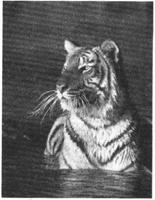
We also take trips once in a while to “experience” wildlife. Most of us see it as something existing in a distant place, cut off from the busy city or village life that we live. Is it that? Should it be that way? Is it related to our lives too? Just few hundred years ago, most of the places on earth had rich wildlife (plants, animals, insects etc.) that existed there for millions of years. Then what happened in the last few hundred tears to change all that?
Is it that? Should it be that way? Is it related to our lives too? Just few hundred years ago, most of the places on earth had rich wildlife (plants, animals, insects etc.) that existed there for millions of years. Then what happened in the last few hundred tears to change all that?
Today, if one wants to see some wild animal, one has to go to either a zoo or a protected forest area. How did it all happen? Will there be anything called wildlife, 100 tears later? Wildlife essentially includes all forms of life.
For millions of years, our ancestors lived in harmony with nature in wilderness other than hunting once in while for satisfying hunger. This continued till modern science and technology came in the last few hundred years. Human interference in many forms of advanced technology have made way to reach even the “darkest” forests of the world and today there is nothing much left to be exposed.
This has resulted in tremendous amount of damage to wildlife all around the world. We started hunting for game, fun and destroyed forests. Many species have become extinct in the last few hundred years due to human activities. Now, is wildlife something that is to be separated from us and different from us?
All of us know that humans as well as other oxygen breathing life forms do not have existence without the only oxygen producing factories in the world-the plants. Plants have fed the world and cured its ills since life began. Now, human beings are destroying these habitats at the rate of 150 acres per minute. This obviously results in loss of home for a large number of other creatures dependent on them.
Geographically and climatically different parts of the world have different types of life forms adapted to live there. This has resulted in a huge diversity in the life forms that we see on earth. Did you know that three are about 3,80,000 different species (kinds) of plants alone on earth? Vertebrates (animals with back bones) consists of about 46,000 species only. Of which about half the species are fish, 4200 mammals and 8700 birds. In addition to all these, there are about 1.4 million species of invertebrates. Different animals and plants require different climate, temperature, light water availability etc. for their survival. This is the reason why we do not see kangaroos in Indian forests or tigers and lion in Australia. This also tells us that it is very important to protect the habitat (living space, including plants water, air, soil etc.) of each of these species for their healthy survival. Tropical countries like India, Brazil, Indonesia etc. are very rich in the number of life forms living there.
In other words, this can be called the “biodiversity” of the place. In India itself, the regions which get maximum rains like the Western Ghats and some parts of Eastern India including Assam, Tripura etc. have rich wildlife and biodiversity due to this. This kind of tropical rainforests used to exist as a ring around the equator of the earth. They are one of the most complex and diverse forests with no marked seasons, days and nights of equal length and heavy rains. The trees here grow to average heights of 60 meters and many layers of life exist underneath. These include shade-loving plants, various types of climbers, epiphytes which grow on tree branches and even minute hanger-on plants called microphylls which can grow on large leaves of other plants etc. These forests are also home for a whole lot of exquisite species of animals, birds, insects, aquatic creatures etc. 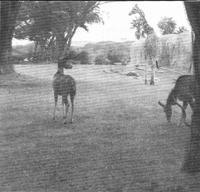
Today, very little of the tropical rain forests are left without destruction. Similarly, other geographic regions which get less sunlight and rain will cater to various other life forms that can survive there. Have you ever wondered why there are so many different species? How our daily activities are affecting nature and wildlife that looks alien to us? Many organisms make use of other types of organisms: trees use animals as pollinators and seed dispersers, and microorganisms transport nutrients from one individual organism to another. All the while, creatures are competing with each other for food or light, or simply for space; simultaneously, many exploit others for protection against still others.
Yet, however vigorous the struggles to stay alive, there are obviously checks and balances. Plant eaters consume plants but do not eliminate them, and eaters of plant-eaters gain enough sustenance to keep going without generally causing final harm to their prey species. It is difficult for the observer to track down all these inter-relationships that maintain all of us. The various strands of life clearly make up an ecological web.
But what is the nature of the overall picture that we may perceive in the forest’s workings? We can say, every life form finds ways for all to live with each other, on each other, off each other, through each other-building up this web of life. You know what happens if you pull out one of the strands of a spider’s web. Similarly, the various species that constitute the “web of life” will get affected by damages that we or any other species do to it.
Cutting and cleaning of natural forests are a big problem. Deforestation for agriculture and to rear cattle in large scale is done by North America in the tropical forests of South America. Similarly, due to population growth, many other parts of the world are facing loss of wildlife. But, we can make a difference. They can make an effort to purchase the most ecologically sensitive products. Recycled paper is readily available. Such a product can reduce the demand for timber.
Another method is to purposely avoid harmful products by boycotts. Can you find out ways in which you would like to reduce damage to wildlife and nature? Write to JM and share your ideas with others. Recent reports by the world Resources Institute have shown that more than 80% of the planet’s natural forests have already been destroyed”. Humankind is the cause of deforestation. Forests are disappearing from earth at the following rate:* 2.47 acres/sec* 150 acres/minute* 214,000 acres/day* 78 million acres/year!
Illusions
Basically, the eye is like a camera with an image-forming lens in front of a screen. This “analysis” of eye vision is enough to appreciate certain perplexing optical illusions.
The “screen” of the eye is the retina. Most striking is its shape- it is nearly spherical. When focused, an extended object forms a curved image. The retina is curved to accommodate this distortion of the image.
On this curved surface are photoreceptor cells. Light from the crystalline lens has to go through a tangle of optical nerves before reaching photoreceptors. 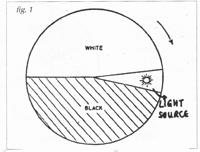
There are two types of photoreceptors, the rods and the cones, so named because of their external appearances. They are not evenly distributed throughout the retina. Rods are nearly absent at the center and increase in density as one goes to the periphery. On the other hand cones are concentrated near the center and are almost absent at the periphery. In other words, we have a cone-rich centre surrounded by a rod-rich periphery.
The rod cells respond only at a low level of light, while the cones are active only at high levels of illumination. So night vision is mostly through the roads while day vision is confined to the cones. The rods and the cones also do not respond the same way to colours. The rod cells hardly “see” any colour, but for a low response in the blue. On the other hand the cones respond to colours. In fact one can picture them as belonging to three different types, responding in the blue, green and red regions of the visible spectrum. The discrimination in rod and cones response together with their distribution on the retina results in a few interesting illusions.
A photoreceptor remains “dead” for some time after receiving a signal. In other word it is “fatigued”. This mechanism can result in intensity and colour being assessed wrongly. This fatigue leads to a problem which we all know very well: a room looks darker if we enter it from the sunshine. The retina is fatigued by the bright light and it is inactive to receive any light that is present in the room. After some time the photoreceptors regain their original state and are “ready” to receive light.
Fatigue can also result in what is termed as an after image. If one sees a bright object for some time and then shifts she gaze to a white wall, then against a white background a “dark” image of the object is seen. The portion of the retina that had received the image is now “sort of dead” and inactive while the rest of the retina is fully operative. This is generally called the negative after image in view of its complementary nature.
But there are also coloured after images. If one stares at a red object against a white background for some time and then removes the object, a greenish image of the object is seen in the same place. Of the three types of cones in the region of the image, the red sensing cones get fatigued and are thus inactive. Then that particular region can see only a complementary hue: bluish-green. Can you guess now why doctors and nurses wear a bluish-green dress in operation theaters?
A rotary disc with a notch (Figure1) brings out this effect beautifully. With a green-coloured lamp behind the notch, the limp appears green rotating one way, but reddish turning in the other direction. Which sense of rotation will give you a green colour? Why?
The interesting aspect of coloured after image is that the three different types of cones do not have the same amount of “fatigue”. There is an interesting toy which exploits this illusion. Its beauty is so impressive that even the Nobel Prize winner Richard Feynman discusses it in the famous Feynman Lectures on physics. 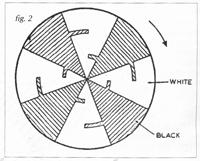
A pattern of the type shown in Figure 2 is fixed to a rotating disc. When the disc is rotated, on of the darker rings appear coloured with one colour and the other with another. The colour depends on the speed of the rotation, on the brightness of illumination and often on who sees it. This can be understood as a complicated manifestation of the different rates after having been exposed to white light. Many variations of this have been designed. Enhanced colour dynamics can be experienced when seen under a fluorescent lamp.
You can very easily make these discs yourself. Do write to Jantar Mantar what your experience was with these rotating discs.
Don’t blow it!
-Deepak Khemani, P. B sunil kumar I.I.T Madras
Blowing your nose drives virus-laden mucus deep into the sinuses, a new study concludes. Sneezing and coughing don’t do this, although of course they increase the chance of spreading your germs to friends, family and workmates. 
Our sinuses are usually filled with air. But in about 85% of people with a cold, they contain viscous fluid. Clearly, it got there from the nose, but how?
A team of the University of Virginia in the USA examined CAT scans of the sinuses of people with a cold and found the fluid had bubbles. How did these bubbles form?
The mucus could have mixed rapidly with air if it entered the sinuses under high pressure. To try to understand how that might happen, the team members inserted thin straw-like pressure gauges into the nostrils of volunteer patients. They found that each nose blow produced a rapid change in pressure. In the space of one second, the pressure shot up to an average of 8800 pascals about half the pressure of blood in a major artery. Sneezing and coughing, on the other hand, produced only a tenth of the pressure of a nose blow, hardly enough to get mucus moving.
To see if these calculations were correct, the researches placed artificial mucus, made from a sugary gel, up the noses of 10 more subjects and used a CAT scanner to follow its journey. After a sneeze or a cough, the liquid stayed in the nasal passages, but a nose blow shot the gel deep into the sinuses.
Ronald Turner, a cold specialist at the Medical University of south Carolina in Charleston, says that people with colds don’t need to worry too much: they rarely get severe sinus infections.
The Eradication of Smallpox
One of the most feared diseases in our history is smallpox. Beginning in the early nineteenth century and extending well into the twentieth century, India has witnessed repeated epidemics of this dreaded disease.
Each time an epidemic broke out lakhs of Indians would perish. A large number of those that died were children. 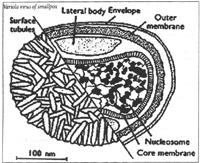
At the time of independence, it was estimated that the number of deaths due to smallpox was upward of 70,000an year. And that was when there was no major epidemic on. During a major epidemic, deaths could be much higher.
Deaths were only a part of the problem of smallpox. Many who survived were disfigured by the disease. Indeed, ours is the first generation growing up where a large number do not bear the tell-tale marks of smallpox on their face. Worse, a large number of those affected by smallpox were blinded by the disease.
WHAT IS SMALLPOX?
Smallpox is a disease caused by a virus, called the variola virus. A person infected by the virus develops, after a gap of some ten to twelve days, a body rash made up of a number of vesicles. A vesicle is a small bleb filled with clear fluid. Soon these vesicles become infected and are called pustules. About the tenth day, if the person has not died by then, these vesicles dry up and from scabs. These later fall off leaving scars behind.
In many ways this disease is much like chicken pox, a disease that is common even today. Fortunately, chicken pox runs a much milder course. The fever is less, the rash is less and leaves no scars, and seldom does it kill. Measles too is a similar virus-caused disease. Only there are vesicles seen. A red blotchy rash is what is seen in measles.
All these diseases are very infectious. Most of the persons who come into contact with the affected person; or the scabs from their skin vesicles, will get the disease. However those who have had these diseases even once will never have a second attack of the same. The disease gives life long immunity to those affected.
Scientists had discovered that if a healthy person is infected with some closely related but non-serious disease, like cowpox, then that person becomes immune to smallpox .This knowledge was used to develop vaccination at the end of the eighteenth century.
It is now know that, in India, indigenous medical systems had also discovered a way to immunize people against smallpox. There were a specially trained group of healers called tikadars. Using material carefully collected from scabs, healthy people would be inoculated by these tikadars. These inoculations would be accompanied by a lot of rituals, including prayers in order to appease the goddess who was associated with this disease.
The way this approach worked had been studied by Englishmen and even presented in scientific meetings in London in the mideighteenth century. Perhaps it was this that prompted the development of vaccination in the west. In India where the tikadars had worked, there was much less opposition to inoculation on religious grounds. But in places where such a tradition was note there and where ever proper efforts had not been made to inform people of how vaccination could help, there was often considerable opposition to this.
- HOW WAS SMALLPOX RADICATED?
Though vaccination against smallpox had begun even during British rule, such efforts were limited being largely confined to the major cities and towns and those places where the British lived or had economic interests in. After independence, these immunization campaigns were expanded to cover the entire country. But even then it was not possible to control the disease.
The real breakthrough came with a better understanding of the disease especially the knowledge of the time between getting infected with the virus and the disease showing up as vesicles and fever. Based on this knowledge, an approach called surveillance-containment was initiated, along with mass vaccination. This simply meant that whenever a case of smallpox occurred, news would immediately be sent to the authorities who would rush to the place and isolate the patient from the others.
Not only the sick person, but all those who had come into contact with him in the last two weeks had also to be isolated and immunized. As well as immunization for all those in that neighborhood. Obviously this needed a major effort. Thanks to the roll of the world Health Organization, the resources and will to launch such a major effort not only in India but in the entire world became available.
On 25 May 1975, the last known case of smallpox in India was identified, registered and contained. On 5th July 1975, India was declared to be not endemic for smallpox .Two years later, when no further case had been reported, India was finally declared smallpox free. On 8th May 1980, WHO declared that smallpox had been eradicated from the entire world.
Other Diseases and theri Eradication
Eradication has been tried for malaria, polio, filaria, tuberculosis, guinea worm, kalaazar, leprosy, plague, cholera, measles, trachoma, diphtheria and whooping cough. Unfortunately, success with most of these diseases has been much more limited. Many of these programmes have even been labelled as failures.
Why did the campaign against smallpox succeed? Why were we not so successful with the other diseases?
Largely because of the nature of the disease.Smallpox has no animal reservoir. Meaning it does not infect animals. In contrast, plague remains amongst rats and some other wild animals. So though all human cases have been cured many years back, it could still break out in an epidemic from a few years back. In some diseases like Japanese encephalitis (brain fever), animal reservoirs have such a major role that it has not been possible to even think of a disease eradication strategy.
Another advantage with smallpox is the absence of human carriers. If one takes a disease like filaria or hepatitis (one of the major causes of jaundice) or typhoid, the fact that many individuals may have the germ and may actively be spreading the disease, though they themselves are not affected by the disease, is a major problem in controlling these diseases.
Another advantage that smallpox had is that it is so easy to recognize, even to an untrained person.Makes it easy for surveillance and to isolate the infected person. The relatively longer time it takes for transmission also helps to isolate an outbreak. Measles, in contrast, is very difficult to recognize and it spreads so fast.
Vaccines have been developed for smallpox, which so far has not been possible for a disease like malaria. Even for cholera, the best vaccines give only a limited protection for a limited time.
Among all the infectious diseases, there are only three that are possible to eradicate within the next few years.That, too, only if the authorities plan and implement it seriously enough.
The first of these is the guinea worm disease which spreads through drinking unsafe drinking water. The infective worm is so big that even straining the water through a cloth will prevent its spread. It is also a disease without carries and that is very easy to identify. Today it exists in only a very few villages.
The second is leprosy. This too is easy to identify, has no animal hosts and is transmitted very slowly. If all cases are detected, by well organized campaigns conducted with people’s understanding and support, and these cases are treated with the very effective drugs that are now available, this disease can be eliminated. However in practice such a major effort has just never been tried except in some pockets.
The third disease which can be eradicated now is polio. This is mainly due to the availability of a vaccine, which if given every year for all children below 5 years of age for a few years- the disease can be expected to disappear. At present a lot of effort is going into this.
Does this mean that all the other diseases cannot be eradicated or controlled? Not so. Not so at all. If one looks at countries in Europe or Japan, one learns that these countries too and had many of these diseases once, but now have managed to control most of them. This they did by improving nutrition, by provision of safe drinking water and sanitation, by ensuring better living and working conditions, and by a letter over all development of health services. In most of these countries almost 80% of all that is spent on health is by the government, In India in contrast only about 20% of the expenses is by the government. So though smallpox is a great success story we have to plan differently if we have to improve the health status of Indians which is now one of the worst in the world. That is one of the most important challenges of the next century.
The Story of Malaria
It is estimated that at the time of independence, the number of people affected by malaria annually was more than 70 million. That is about one in four of the entire population of the country used t get the disease in any given year. One can imagine how much suffering it meant. Not only that, it meant such a great economic loss to the country- to have so many people sick, instead of being at work. And of these it is estimated that every year one million people died of the disease! No wonder than that there was so much joy and celebration when the nation was able to launch a successful compaign against this disease. The number of cases dropped dramatically and in the early sixties only about half a lakh persons were estimated to be affected every year.
There were no deaths. Unfortunately this was not to last. The number of cases started to go up and soon there were again about eight million cases every year. Another renewed campaign was launched but this could bring the cases down to about three million cases per year.
This was the best that could be achieved. And even this is rising steadily year after year. But the worst news is this. The type of malaria spreading now is a form that is much more dangerous and which responds much less to available drugs. What went wrong? That is a long story.
To put it in brief, the reliance only on pesticides to destroy the disease spreading mosquitoes, and the failure to make this part of a process where people understand and participate in mosquito control as part of a general improvement in their living conditions, lies at the root of this failure. This is much more evident in a disease like tuberculosis, where no simple technological solution was ever available. At independence there were 2 million cases and five lakh deaths per year. Now there are over 12.5 million cases and five lakh deaths per year!
- T. Sundararaman JIPMER, Pondicherry
Does the hole become larger or smaller or does it remain the same size?
A piece of solid iron in the shape of a doughnut is heated over a fire. As the iron expands, does the hole become larger or smaller or does it remain the same size?
As the doughnut or the ring expands, it keeps its same proportion; so the hole also gets bigger. This same principle is at work when an optician removes a lens from a pair of glasses by heating the frame. To understand why the proportions stay the same you have to consider the individual atoms of iron and how they bond with each other. When a substance is heated it expands, it’s the average distance between particles that grows not the particles themselves. In other words, the bonds stretch due to the particles moving slightly greater distances apart. Now substitute an iron atom at the edge of the ring hole and the same reasoning suggests the iron atoms is more likely to end up backing away from the hole (enlarging it) rather than jumping in (and shrinking it). These bonds mean that the pull of the majority trying to enlarge the hole wins out over the minority trying to shrink it. The next time you can’t undo the metal screw type lid on a stubborn jar heat the lid under hot water. The lid will expand, making it easier to loosen.
What would happen to the water level if you threw the rocks into the water?
If you were in a boat in a small swimming pool (so that you could measure the water level) and there were rocks in the boat, what would happen to the water level if you threw the rocks into the water? Would it rise lower or remain the same level as when the rocks were in the boat? 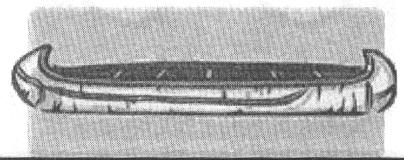
Let us note that rock sinks because overall density of rock is greater than that of water. When a rock is in the boat Archimedes principle tells us that the weight of the volume of water displaced due to that rock is equal to the weight of the rock. Since the rock is denser boat than water, this displaced volume of water is larger than the volume of the rock (weight = mass density x volume X g, the acceleration due to gravity). But when the rock is at the bottom of the pool it merely displaces a volume of water equal to the rock’s volume. Hence more water is displaced when the rock is in the boat than when the rock is at the pool bottom. There fore the water level will drop each time a rock is thrown out of the boat into the water.
Why is it easier to maintain your balance on a moving bicycle than on a stationary one?
The point of contact with the ground in both cases is well below the center of mass.bicyle This means that when moving there is a net angular momentum about that “pivot” point. If you are slightly off balance, your center of mass is not directly over the pivot point but to one side of it. Then the force of gravity starts pulling you down, but because of the angular momentum (just like with a gyroscope) this gets changed into a turning motion – you change direction a little by leaning to one side or the other and if you keep leaning in the same direction you will go around in circles. Of course there is some point (you lean too far, or slow down too much) where gravity wins out and you just fall over. But the faster you are going the more stable you will be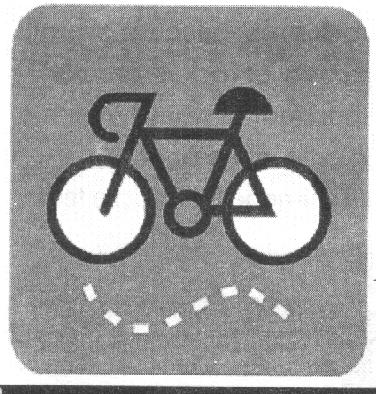
Will an igloo eventually melt if heated by stove or other means?
Igloo is a house made using iglo girlice blocks and snow. It is mostly used by Eskimos in countries around the North Pole. The inside temperature of igloo is maintained between 0 to -7 degrees centigrade. The outside temperature ranges between 20 to – 40 degree centigrade. Building an igloo is easy and fun. And the igloo is a great place to spend the night on a small expedition in the cold mountains. Building an igloo will take somewhere between 3 and 6 hours, depending on your level of ambition. An igloo can serve as a shelter because the walls are made rather thick and there for they are resistant to heat flow through them. And too the interior is heated by oil lamps and the body heat of its occupants. The hot gases of the stove or other heat source can heat the ice up to zero degrees centigrade. 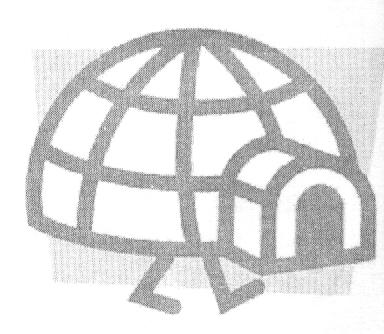
However, it is unlikely that this would even happen. it would take quite a lot of heat. Let us say you do happen to melt a thin sheet of ice on the outside of the ice block (s) that make up this igloo. Ice and snow have a low coefficient of thermal conductivity [0.005 and 0.00026 (cal/sec)/ (cm2x c/cm)] which means ice and snow do not leak a lot of heat by conduction. Of course, it is NOT impossible to melt an igloo.
Why don’t trains traveling across open countryside get struck by lightning during thunderstorms?
K Narayan Kumar, Chennai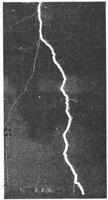
Lightning is caused when a large static charge develops in the rain clouds. The large voltage difference that develops between the clouds and the earth results in a current discharge from the clouds to the ground. Trees and building are bad conductors of electricity. When lightning strikes such objects, they are not able to conduct the charge from the cloud to the ground. As a result, the excess charge accumulates at the top of the object. Eventually, there is a massive spark that chars the object. However when lightning hits something metallic which can conduct all the way to the ground, like a train (both the body of a train and the rails are made of metal) the charge finds a path and flows safely to the ground.
Why does a train travel slowly over a bridge?
You may not have thought about it, but the forces on a bridge when a fast train moves onto it are enormous! To these add the pounding of the wheels and the sideway of the train. If a train is braked or started on a bridge, the drag (or push) is also very heavy. Railway bridges, therefore, must meet much more stringent requirements than highway bridges. As the trains moving onto the bridge becomes heavier and faster, these requirements become tougher and tougher to meet. So, to make things easier for bridge designers, trains travel slowly and at a uniform speed over a bridge. Further, when a train goes over a bridge, it sets the bridge vibrating. If the vibration were at the resonating frequency of the bridge, it would surely collapse. The slow speed of the train also makes sure that the frequency with which the bridge vibrates when the train is still over it is not its resonating frequency.
Is the sea blue because the sky is reflected in it?
No, the answer is that it is due to scattering. When light interacts with tiny particles of dust or molecules (which are smaller than its wavelength), it gets scattered. The bluer the light (the smaller its wavelength), the more it gets scattered. Since light at the blue end of the spectrum has the smallest wavelength, blue light gets scattered most. That is why the sky is blue. The sea can not be blue because of reflection of the sky light. We do not see it having a red colour at sunrise or sunset! It was believed that the sea’s blueness was because of scattering by solid particles (dust) in the water. When Dr. C.V. Raman was travelling to England from India he was very impressed by the rich blueness of the Mediterranean sea. After coming back to India, Raman explained that the scattering was actually due to the water molecules themselves.
Why does our nose have mucus?
Actually it is not only our nose that has muscus. There is mucus in our intestines and there is mucus in the lungs too. And depending upon where it is present the mucus performs different functions. The mucus in our nose acts like a filter. It traps dust particles from the air we breathe. It also traps bacteria and other microorganisms that the air may contain and kills them. The mucus performs another useful function. The nose has smell receptor cells in a special cavity in the mucus membrane. The odour molecules inhaled through the nose dissolve in the mucus and stimulate hair like endings of these cells. They generate nerve impulses which reach the brain. This sharpens our sense of smell.
When ironing clothes, why do we sprinkle a little water on them?
Clothes are made of fibre. Natural fibres are made of molecules made a long carbon chains, like cellulose.When they come into contact with water, these chains absorb the water and align. This helps remove the creases on the cloth. The hot iron then dries out the water while keeping the fibres pressed straight. This leaves the cloth “ironed out”.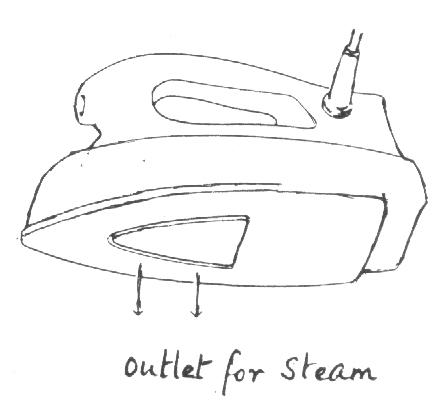
When you look at something beyond a fire, what you see seems shimmering and hazy. Why?
The air above a fire is heated to different levels. Near the flames, it is hottest; farther away, it is less hot. As the flames flicker, this temperature gradient keeps changing. Air at different temperatures has different destiny and different refractive index. Hence what you see beyond the fire is seen through layers of air which refract differently, and the pattern of refraction changes with the flickering of the flame. To the observe, therefore, it appears as thought the image on the other side is shimmering and hazy.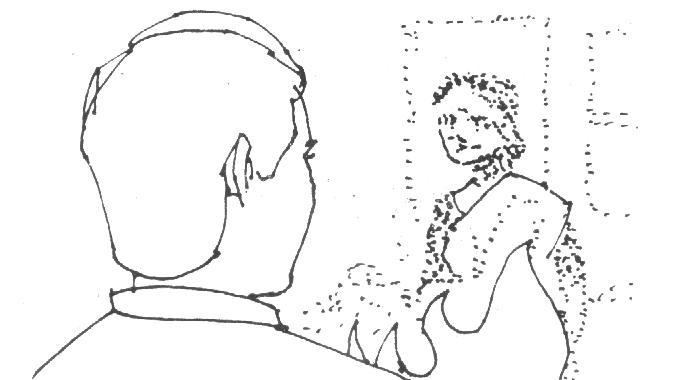
Why do mustard seeds splutter when put into hot oil?
Mustard seeds have a hard coat inside which is an oily substance. When mustard seeds are heated, the oil inside (which is different from the oil outside) heats up and expands, breaking open the hard coat. This is what makes the mustard seeds splutter. Other things, like chilies, splutter in oil differently. They have water inside them, and when this water comes out, the chilly might burst. But after that, the water is heated and converted into steam. This steam bubbles through the oil leading to a
We need oxygen to live, but how much of it? Is it harmful to breathe 100 percent oxygen? What will happen?
In fact, breathing 100 percent oxygen is harmful. How much trouble it causes for you, though, depends upon the pressure of the oxygen (normal air pressure is 760 torr or 1 atmosphere) and the time of exposure? Before we discuss the effects of breathing 100 percent oxygen, let’s look briefly at how our lungs work. Your lungs are basically a long series of branching tubes from your nose and mouth (trachea to bronchi to bronchioles) that end in little thin-walled air sacs called alveoli ( singular – alveolus), much like soap bubbles on the end of a straw. 
Each alveolus is lined with a single layer of epithelial cells. Surrounding each alveolus are small, thin-walled blood vessels lined with a single layer of epithelial cells called pulmonary capillaries (pulmonary because they are found in the lung).Between the capillaries and the alveolus is a thin wall (about 0.5 microns thick) through which various gases (oxygen, carbon dioxide, nitrogen) can exchange between the air space of the alveolus and the blood in the capillary. When you breathe in air the alveolus fills with this air. Because the oxygen concentration is high in the air and low in the blood entering the pulmonary capillary, oxygen flows from the air into the blood. Likewise, because the concentration of carbon dioxide is higher in the blood entering the capillary than it is in the alveolar air, carbon dioxide moves from the blood to the alveolus. 
The gases exchange across the alveolar wall and the air inside the alveolus becomes depleted of oxygen and rich in carbon dioxide. When you breathe out, the alveolus empties this carbon-dioxide enriched, oxygen poor air Breathing 100% pure air can cause acute oxygen poisoning. This damage was probably caused by a highly reactive form of the oxygen molecule called the oxygen free radical, which destroyed proteins and membranes in the epithelial cells. The nitrogen concentration in the blood and the alveolar air is about the same. But presence of 100% oxygen can to nitrogen being removed from blood.
How big should a shooting star be in order for us to see it with our eyes?
We have all seen some spectacular meteors and meteor showers. Discussing meteor activity can be tricky because the terminology is confusing. The term meteor actually refers to the streak of light caused by a piece of space debris burning up in the atmosphere. The pieces of debris are called meteoroids, and remnants of the debris that reach the earth’s surface (or another planet’s) are called meteorites. Meteoroids have a pretty big size range. They include any space debris bigger than a molecule and smaller than about 100 meters; space debris bigger than this is considered an asteroid. But most of the debris the earth comes in contact with is “dust” shed by comets traveling through the solar system. This dust tends to be made up of fairly small particles.
So how can we see a meteor caused by such a small bit of matter? It turns out that what these meteoroids lack in mass they make up for in speed and this is what causes the flash of light in the sky. Meteoroids enter the atmosphere at extremely high speeds – 11 to 72 kilometers per second. They can travel at this rate very easily in the vacuum of space because there’s nothing to stop them. The earth’s atmosphere, on the other hand, is full of water, which creates a great deal of friction on a traveling object. This friction generates enough heat (up to 1600 degrees Celsius) to raise the meteoroid’s surface to its boiling point, so the meteoroid is vaporized, layer by layer. The friction breaks the molecules of both the meteoroid material and the atmosphere into glowing ionized particles, which then recombine, releasing light energy to form a bright “tail.”
A meteor tail caused by a grain sized meteoroid is a few feet wide (about a meter) but, because of the high speed of the debris, may miles long. So how bit does meteoroids have to be form visible meteors? Estimates for the minimum size vary. This is because there are factors other than size involved. Most notably, a meteoroid’s entry speed affects its chances of reaching the surface, because it determines the amount of friction the meteoroid experiences. Typically, though, a meteoroid would have to be about the size of a marble for a portion of it to reach the earth’s surface. Smaller particles burn up in the atmosphere about 80 to 120 kilometers above the earth. The meteorites a person is likely to find on the ground probably came from significantly larger meteoroids – pieces of debris at least the size of basketball, typically, since larger meteoroids usually break up into smaller chunks as they travel through the atmosphere.
I know it has something to do with our ears, but what exactly makes people dizzy when the spin?
When you become dizzy, a part of your body that senses motion has sent the wrong signal to your brain. An amazing system in your inner ear is the key to dizziness. The body senses whether it is upright or lying down or weather it is moving or standing still through the vestibular system, which is in the upper portion of the inner ear. Here is how the vestibular system senses motion:
There are three semicircular canals for sensing motion. They are at right angles to one another. They contain fluid called endolymph and hair-like sensory nerve cells. As your head moves in a given direction, the endolymph lags behind because it resists a change in motion (the principle of inertia). The lagging endolymph stimulates hair cells to send nerve signals to the brain. The brain interprets them to know which way the head has moved. When you spin, the endolymph slowly moves in the direction you are spinning.
The movement of the endolymph signals the brain the head is spinning. The brain quickly adapts to the signal because the endolymph begins to move at the same rate that you are spinning and no longer stimulates the hair cells. However, when you stop spinning, the endolymph continues to move and stimulate hair cells in the opposite direction. These hair cells send signals to the brain the brain determines that the head is still spinning, even though you have stopped. This is where the dizzy feeling come from.
Eventually, the endolymph stops moving, no signals are sent to the brain, your brain determines that your motion has stopped and you no longer feel dizzy. Try this short experiment, unless you are extremely sensitive to dizziness: spin around 5-10 times rapidly to the right and stop. When you stop, you will feel slightly dizzy as described above. When you have recovered, repeat step1, but when you stop this time, immediately spin a couple of times to the left and stop. You should now find that when you stop, you do not feel as dizzy. In the second situation, you have begun to move the endolymph in opposite directions and the two effects of motion tend to cancel out.
There is a strong, funny smell after it rains. Sometimes it is a good Smell, and sometimes it is unpleasant. What causes this smell?
the more pleasant rain smells, the one we often notice in the woods, is actually caused by bacteria! Actinomycetes, a type of filamentous bacteria, grow in soil dries out, the bacteria produces spores in the produces spores in the soil. The wetness and force of rainfall kick these tiny spores up into the air where the moisture after a rain acts as an aerosol (just like an aerosol air freshener). 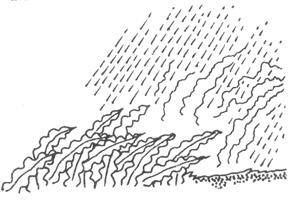
The moist air easily carries the spores to us so we breathe them in. These spores have a distinctive, earthy smell we often associate with rainfall. The bacteria is extremely common and can be found in areas all over the world, which accounts for the universality of this sweet “after – the – rain” smell. Since the bacteria thrives in moist soil but releases the spores once the soil dries out, the smell is most acute after a rain that follows a dry spell, although you’ll notice it to some degree after most rainstorms.
Another sort of smell is caused by the acidity of rain. Because of chemicals in the atmosphere, rainwater tends to be some what acidic, especially in urban environments. When it comes in contact with organic debris or chemicals on the ground, it can cause some particularly aromatic reactions. It breaks apart soil and releases minerals trapped inside, and it reacts with chemicals, such as gasoline, giving them a stronger smell. These reactions generally produce more unpleasant smells than bacteria spores, which is why the after-the-rain smell isn’t always a good one. Like the smell caused by the bacteria spores, the small of chemical reactions is most noticeable when it rains following a dry spell.
This is because once the chemicals on the ground have been diluted by one downpour; they don’t have the same reaction with the rainwater. Another after-the-rain smell comes from volatile oils that plants and trees release. The oil then collects on surfaces such as rocks. The rain reacts with the oil on the rocks and caries it as a gas through the air. This scent is like the bacteria spores in the most people consider it a pleasant, fresh smell. It has even been bottled and sold for its aromatic qualities!
These are a few common rain smells, but there are also all sorts of other scents after it rains. There is plenty of aromatic material that the moisture and impact of rain can stir up, and the moist atmosphere following a downpour is particularly good at carrying these particles through the air. So, when you talk about the after-the-rain smell with a friend, you may mean one thing while your friend is thinking of something else. You’ll both agree, however, that the air has a much stronger aroma to it after a good rain.
We often read about windows that are “bulletproof.” Does bulletproof glass really exist, and if so, how does it work?
At first glance, bullet-resistant glass looks identical to an ordinary pane of glass, but that’s where the similarities end. An ordinary piece of glass shatters when struck by a single bullet. Bullet resistant glass is designed to withstand one or several rounds of bullets depending on the thickness of the glass and the weapon being fired at it. So, what gives bullet-resistant glass the ability to stop bullets? Different manufactures make different variations of bullet-resistant glass, but it is basically made by layering a polycarbonate material between pieces of ordinary glass in a process called lamination. This process creates a glass-like material that is thicker than normal glass. Polycarbonate is a tough transparent plastic. Bullet-resistant glass is between 7 millimeters and 75 millimeters in thickness. A bullet fired at a sheet of bullet-resistant glass will pierce the outside layer of the glass, but the layered polycarbonate –glass material is able to absorb the bullet’s energy and stop it before it exits the final layer.The ability of bullet-resistant glass to stop a bullet is determined by the thickness of the glass. 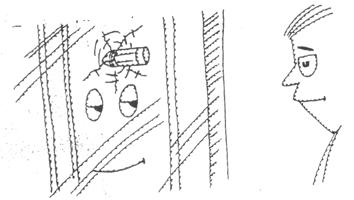
A rifle bullet will collide with the glass with a lot more force than a bullet from a handgun, so a thicker piece of bullet-resistant glass would be needed to stop a rifle bullet as opposed to a handgun bullet. There is also one-way bullet-resistant glass available, which has one side able to stop bullets, while the other side allows bullets to pass through it unaffected. This gives a person being shot at the ability to shoot back. This type of bullet-resistant glass is made by laminating a brittle sheet of material with a flexible material. Imagine a car equipped with this one-way bullet-resistant glass. If a person outside the car shoots a bullet into the window, the bullet would strike the brittle side first. This brittle material would shatter around the point of impact and absorb some of the energy over a large area. The flexible material then absorbs the remaining energy of the bullet, stopping the bullet. A bullet fired from inside the same car would easily pass through the glass because the bullet’s force is concentrated on a small area, which causes the material to flex. This causes the brittle material to break outwards, allowing the bullet to pierce the flexible material and strike its target.
If global warning causes the polar ice caps to melt, how much will the oceans rise?
It seems that in the last 100 years the earth’s temperature has increased about half a degree Celsius. This may not sound like much, but even half a degree can have an effect on our planet. According to the U.S Environmental protection Agency (EPA) the sea level has risen15to 20 cm in the last 100 years. The rising temperature and icebergs could play a small role in the rising ocean level. Icebergs are chunks of frozen glaciers that break off from landmasses and fall into the ocean. The rising temperature may be causing more icebergs to from by weakening the glaciers, causing more cracks and making ice more likely to break off. As soon as the ice falls into the ocean, the ocean rises a little. If the rising temperature affects glaciers and icebergs, could the polar ice caps be in danger of melting and causing the oceans to rise? This could happen, but no one knows when it might happen. 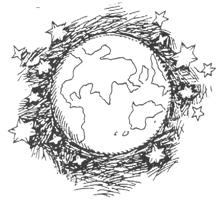
The main ice covered landmass is Antarctica at the South Pole; with about 90 percent of the world’s ice (and 70 percent of its fresh water) Antarctica is covered with ice an average of 2,100 meters thick. If all of the Antarctica ice Melted, sea levels around the world would rise about 60 meters. But the average temperature in Antarctica is -370C, so the ice there is in no danger of melting .In fact in most parts of the continent it never gets above freezing. At the other end of the world, the North Pole, the ice is not nearly as thick as at the South Pole. The ice floats on the Arctic Ocean. If it melted sea levels would not be affected. There is a significant amount of ice covering Greenland, which would add another 7 meters to the oceans if it melted. Because Greenland is closer to the equator than Antarctica, the temperatures there are higher, so the ice is more likely to melt. In 1995 the International panel on Climate Change issued a report which contained various projections of the sea level change by the year 2100. They estimate that the sea will rise 50 centimeters (20 inches) with the lowest estimates at 15 centimeters (6 inches) and the highest at 95 centimeters (37 inches). The rise will come from thermal expansion of the ocean and from melting glaciers and ice sheets. 20 inches is no small amount – it could have a big effect on coastal cities, especially during storms.
The sky is blue, but why are sunsets red and orange?
We know that the sky is blue because tiny particles in the atmosphere (dust, clumps of air molecules, microscopic water droplets) are better at deflecting shorter wavelength blue light than they are at deflecting longer wavelength red light. As sunlight passé through the atmosphere, enough blue light is deflected (or more technically Rayleigh scattered) by these particles to give the atmosphere an overall blue glow. 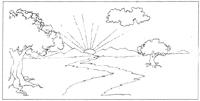
The sun itself is slightly reddened by this process because a fraction of its blue light is deflected away before it reaches our eyes. But at sunrise and sunset, sunlight enters our atmosphere at a shallow angle and travels a long distance before reaching our eyes. During this long passage, most of the blue light is deflected away and virtually all that we see coming to us from the sun are its red and orange wavelengths. The missing blue light illuminates the skies far to our east during sunrise and to our west during sunset.When the loss of blue light is extreme enough, as it is after a volcanic eruption, so little blue light may reach your location at times that even the sky itself appears deep red. The particles in air aren’t good at deflecting red wavelengths, but if that’s all the light there is they will give the sky a dim, re glow.
Why is it easy to stay on a bicycle while moving, but impossible to maintain the balance once it stops?
A bicycle is a typical example of a dynamically stable object. Although the bicycle is unstable at rest (statically unstable), it is wonderfully stable when moving forward (dynamically stable). To understand this distinction, let’s start with the bicycle motionless and then start moving forward. At rest, the bicycle is unstable because it has no base of support. A base of support is the polygon formed by an object’s contact points with the ground. For example, a table has a square or rectangular base of support defined by its four legs as they touch the floor. As long as an object’s center of gravity (the effective location of its weight) is above this base of support, the object is statically stable. That stability has to with the object’s increasing potential (stored) energy as it tips-tipping a statically stable object raises its center of gravity and gravitational potential energy, so that is naturally accelerates back toward its upright position. Since a bicycle has only two contact points with the ground, the base of support is a line segment and the bicycle can’t have static stability. 
But when the bicycle is heading forward, it automatically steers its wheels underneath its center of gravity. Just as you can balance a stick on your hand if you keep moving your hand under the stick’s center of gravity, a bicycle can balance if it keeps moving its wheels under its center of gravity. This automatic steering has to do with two effects: gyroscopic precession and bending of the bicycle about its steering axis. In the gyroscopic precession steering, the spinning wheel behaves as a gyroscope. It has angular momentum, a conserved quantity of motion associated with spinning and this angular momentum points toward the left (a convention that you can understand by pointing the curved fingers of your right hand around in the direction of the tire’s motion; your thumb will then point to the left). When the bicycle begins to lean to one side, for example to the left the ground begins to twist the front wheel. Since the ground pushes upward on the bottom of that wheel, it tends to twist the wheel counter – clockwise according to the rider. This twist or torque points toward the rear of the bicycle (again, when the fingers of your thumb will point toward the rear). When a rearward torque is exerted on an object with a leftward angular momentum, that angular momentum drifts toward the left – rear. In this case, the bicycle wheel steers toward the left. This argument is difficult to follow, but the basic result is simple: the forward moving bicycle steers in the direction that it leans and naturally drivers under its own center of gravity.
You can see this effect by rolling a coin forward on a hard surface: it will automatically balance itself by driving under its center of gravity. In the bending effect, the leaning bicycle flexes about its steering axis. If you tip a stationary bicycle to the left, you see this effect: the bicycle will steer toward the left. That steering is the result of the bicycle’s natural tendency to lower its gravitational potential energy by any means possible. Bending is one such means. Again, the bicycle steers so as to drive under its own center of gravity. These two automatic steering effects work together to make a forward moving bicycle surprisingly stable. This was pointed out by British physicist David Jones in 1970. Bicycles are so dynamically stable that almost anyone can ride them without hands and not tip over! Children’s bicycles are designed to be especially stable in motion (for obvious reasons) and one consequence is that children quickly discover that they can ride without hands. Adult bicycles are made less stable because excessive stability makes it hard to steer the bicycle.
Many of the new cordless phones operate at 2.4 GHz, which is like the frequency of operation of a microwave oven. Is it possible that our ears will ultimately get ‘cooked’ if we keep using them, or is the wattage too small?
As far as anyone has been able to determine so far, the wattage is so small that this microwave radiation doesn’t affect us. Not all radiations are the same, and radio or microwave radiation is particularly nondestructive at low intensities. It can’t do direct chemical damage and at low wattage can’t cause significant RF (radio frequency) heating. At present, there is thus no plausible physical mechanism by which these phones can cause injury. I don’t think that one will ever be found, so you’re probably just fine.
Why are most planets round, with somewhat flattened portions at the poles?
The answer is gravity. Gravity smashes the planets into spheres. To understand this, imagine trying to build a huge mountain on the earth’s surface. As you begin to heap up the material for your mountain, the weight of the material at the top begins to crush the material at the bottom. Eventually the weight and pressure become so great that the material at the bottom squeezes out and you can’t build any taller. Every time you put new stuff on top, the stuff below simply sinks downward and spreads out. You can’t build bumps bigger than a few dozen miles high on earth because there aren’t any materials that can tolerate the pressure. In fact, the earth’s liquid core won’t support mountains much higher than the Himalayas – taller mountains would just sink into the liquid. So even if a planet starts out non-spherical, the weight of its bumps will smash them down ward until the planet is essentially spherical. The flattened poles are the result of rotation – as the planet spins; the need for centripetal (centrally directed) acceleration at its equator causes its equatorial surface to shift outward slightly, away from the planet’s axis of rotation. The planet is therefore wider at its equator than it is at its poles. -From the web-site of “How Things Work”, Howthingswork.virginia.edu
Is it possible to generate electricity directly from heat?
If you have a lot of heat, then you can do what power plants do – you can use the heat to generate steam, and use the steam to spin a turbine. The turbine can drive a generator which produces electricity. This setup is very common, but it requires a fair amount of equipment and space. If you would like to generate electricity from heat in a simple way that has no moving ports, the normal way to do it involves thermocouples. Thermocouples take advantage of an electrical effect that occurs at junctions between different metals. For example, take two iron wires and one copper wire. Twist one end of the copper wire and one end of one of the iron wires together. Do the same with the other end of the copper wire and the other iron wire. If you heat one of the twisted junctions (for example with a match) and attach the two free ends to a voltmeter, you will be able to measure a voltage. Similarly, if you hook the two iron wires to a battery, one junction, will get hot and the other will get cold. Interplanetary satellites that fly toward planets like Jupiter and Saturn are so for away from the sun that they cannot use solar panels to generate electricity. These satellites use RTGs (Radioisotope Thermoelectric Generators) to generate their power. An RTG uses radioactive material (like plutonium) to generate heat and thermocouples convert the heat to electricity. RTGs have no moving parts so they are reliable, and the radioactive material generates heat for many years so they last along time.
I see that an old black and white movie is being released in colour now. How can they manage to do that?
Most of the classic black and white movies have been “colourized”, mainly so that they can be shown on television in colour. It turns out that the process used to add the colour is extremely tedious – some one has to work on the movie frame by frame adding the colours one at a time to each part of the individual frame. To speed up the process, the colouring is done on a computer using a digital version of the film. The film is scanned into the computer and the colouring artist can view the movie one frame at a time on the computer’s screen. The artist draws the outline for each colour area and the computer fills it in. The original black and white film holds all of the brightness information, so the artist can paint large areas with a single colour and let the original film handle the brightness gradients. This means that the artist might only have to add 10or so actual colours to a scene. To speed up the process even more, interpolation is common. From frame to frame there is normally very little variation in the position of objects and actors. Therefore the artist might manually colour every tenth frame and let the computer fill in the frames in between.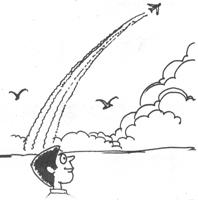
Why do those long white clouds form behind jets flying high over head?
The long white clouds that jets form on certain days are called condensation trails or contrails. Some days the contrail form thin lines that cross the entire sky. Other days they are much shorter, and on some days there are none at all. A contrail forms because one of the components of jet engine exhaust is water. Jet fuel is made of carbon and hydrogen when jet fuel burns with oxygen; most of the exhaust consists of carbon dioxide and water vapour. When you exhale, your breath contains a great deal of invisible water vapour as well. If you are in a cold place (say, up in the mountains), the moisture in your breath hits the cold air. The moisture that cold air can hold is a lot less that what warm air can hold, and the moisture condenses into a visible cloud. The same thing happens when a jet engine “exhales”. If the temperature, winds and humidity in the upper atmosphere are right, long white contrails form when the moisture in the exhaust condenses.
How fast does human hair grow?
It depends. If you just got a rally bad hair cut, then hair seems like it does not grow at all, while hair that one shaves every day seems to grow like weeds! Ignoring these perceptual differences, human hair seems to grow at a pretty consistent rate of about one half of millimeter or so per day, or about half an inch every month (An article in Scientific American quotes a specific rate of 0.44 mm per day). It may grow faster or slower depending on your age, your genetics and your hormonal state (pregnanccy seems to have an effect on hair), but one half of o millimeter a day is a good average. What this means is that the maximum growth rate for hair is about 15 cm (6 inches) per year. If you have short hair and are thinking,” it sure would be nice if I had hair sown to my waist”, then you are going to have a four-year wait!
How does a candle work?After all, wax does not burn without wick, and a wick burns out in seconds if not enclosed in wax.
Candles are one of those things that we take for granted, but they really are amazing – the fuel itself is the package! There are two parts that work together in a candle: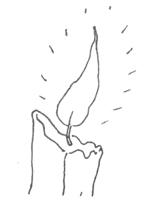
1. The fuel, made of some sort of wax
2. The wick, made of some sort of absorbent twine The wick needs to be naturally absorbent, like a towel, or it needs to have a strong capillary action Un-waxed wick feels like soft string and absorbs water very well. This absorbency is important in a candle because the wick needs to absorb liquid wax and move it upward while the candle is burning. Paraffin wax is a heavy hydrocarbon that comes from crude oil. When you light a candle you melt the wax in and near the wick. The wick absorbs the liquid wax and pulls it upward. The heat of the flame vaporizes the wax, and it is the wax vapour that burns. You can prove that it is wax vapour rather than liquid wax that is burning using two simple experiments:
3. If you place one end of a metal or glass tube (shaped like a thin straw) 10 to 15 cm long into a candle’s flame at a 45 degree angle, you can then light the upper end of the tube. The paraffin vapour flows up the tube and is the fuel for this second flame.
4. When you blow out a candle, you notice a stream of white smoke leaving the wick. This stream is paraffin vapour that has condensed into a visible form. If continues to form as long as the wick is hot enough to vaporize paraffin. If you touch a lit mach to the stream, a flame will run down it and re-light the wick. The reason the wick does not burn is because the vaporizing wax cools the exposed wick and protects it. You may have seen the trick of boiling water in a paper cup. The cup does not burn because the water inside cools it. The liquid wax does the same thing for the wick. Paraffin wax will burn on its own, but it is like cooking oil, motor oil and coal in that you have to get it very hot for combustion to begin. An oil fire is intense and very hard to put out.
Paraffin is the same way in a candle this works great – only the tiny amount of wax on the wick is hot enough to vaporize and burn.
People talk of ‘sixth sense’ since we are supposed to have only five senses. Is it true that there ‘only’ five senses?
The standard list of five doesn’t really give our bodies credit for all the amazing things they are able to do. There are at least a dozen different things we can sense. In order for us to have a sense, there needs to be a ‘sensor’. Each sensor is tuned to one specific sensation. For example, there are sensors in your eyes that can detect light. That is all that they can detect. To track down all of the different senses a person has, the easiest thing to do is to catalogue all of the different sensors. Here is reasonable list:
- In your eyes you have two different types of light sensors. One set of sensors, called the rods, sense light intensity and work well in low – light situations. The other type, called cones, can sense colours (and actually there are three different types of cones for the three primary colours) and require fairly intense light to be activated.
- In your inner ears there are sound sensors.
- Also in your ears are sensors that let you detect your orientation in the gravitational field – they give you your sense of balance.
- In your skin there are at least five different types of nerve endings: heat sensitive 2. cold sensitive 3. pain sensitive 4. itch sensitive 5. pressure sensitive These cells give us the sense of touch, sense of pain, sense of temperature and sense of itch.
- In the nose there are chemical sensors that give us our sense of smell.
- On the tongue there are chemical receptors that give us our sense of taste.
- In your muscles and joints there are sensors that tell you where the different parts of your body are and the motion and tension of the muscles. These senses let us; for example, touch our index fingers together with our eyes shut.
- In your bladder there are sensors that indicate when it is time to urinate. Similarly in your large intestine sensors indicate when it is full.
- There is also the sense of hunger and thirst. Depending on how you want to count it, there are between 14 and 20 different senses listed here. There are some people who do seem to have other senses. For example, there are many people who can sense impending weather changes. And many people feel they can sense when someone else is looking at them. Nobody seems to have any scientific proof for any of these senses yet ….
Why does paper become brown after some time?
Paper is made from wood, which is made up mainly of white cellulose. Wood also has lot of a dark substance in it is called lignin, which ends up in the paper, along with the cellulose. The exposure of lignin to air and sunlight is what turns paper yellow. Lignin makes wood stiff and trees stand upright. You could say it acts as a glue to bind the cellulose fibers together. Newsprint, which must be produced as economically as possible, has more lignin in it than finer papers. At the mill, the wood that will be turned into newsprint is ground up, lignin and all. To make fine white paper, the mill puts the wood through a chemical solvent process, which separates and discards the lignin. Pure cellulose is white, and the paper made from and it will be white and will resist yellowing. Lignin eventually turns paper yellow because of oxidation. That is, the lignin molecules, when exposed to oxygen in the air, begin to change and become less stable. The lignin will absorb more light, giving off a darker color. The lignin will absorb more light, giving off a darker color. If newsprint were kept completely out of sunlight and air, it would remain white. After only a few hours of sunlight and oxygen, however, it will start to change color.
Why do the plugs on some appliances have two prongs and others have three prongs?
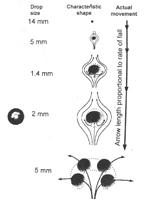
Paper is made from wood, which is made up mainly of white cellulose. Wood also has lot of a dark substance in it is called lignin, which ends up in the paper, along with the cellulose. The exposure of lignin to air and sunlight is what turns paper yellow. Lignin makes wood stiff and trees stand upright. You could say it acts as a glue to bind the cellulose fibers together. Newsprint, which must be produced as economically as possible, has more lignin in it than finer papers. At the mill, the wood that will be turned into newsprint is ground up, lignin and all. To make fine white paper, the mill puts the wood through a chemical solvent process, which separates and discards the lignin. Pure cellulose is white, and the paper made from and it will be white and will resist yellowing. Lignin eventually turns paper yellow because of oxidation. That is, the lignin molecules, when exposed to oxygen in the air, begin to change and become less stable. The lignin will absorb more light, giving off a darker color. The lignin will absorb more light, giving off a darker color. If newsprint were kept completely out of sunlight and air, it would remain white. After only a few hours of sunlight and oxygen, however, it will start to change color.
Flattering of base begins
Concavity of the flattered base begins
At 5 mm the force of the air through which it falls causes drop to break up.
Deformation of water drops in the air
Fuse or circuit breaker for the outlet would detect this huge current and it would cut off the flow of electricity. The fuse prevents the wires in the wall or the outlet itself from overheating and starting a fire. Let’s say that a wire comes loose inside an ungrounded metal case, and the loose wire touches the metal case. If the loose wire is live, then the metal case is now live, and anyone who touches it will get a stock. With the case grounded, the electricity from the hot wire flows straight to ground. What happens if you cut off the ground prong or use a cheater plug so you can plug a three-pin appliance into two-pin outlet? Nothing really-the appliance will still operate. What you have done, however, is disable an important safely features that protects you from electric shock if a wire comes loose.
There are so many toothpastes being advertised. Each of them claims to be different from others. Are they really different from each other?
Toothpaste is not a relatively modern phenomenon. Humans have been clearing their teeth with sticks (Neem tree) and powders (ash) and many other things. The modern versions of toothpaste and toothbrush are just another way of cleaning teeth. How do the toothpastes clean? There main ingredient is an abrasive. Abrasives give toothpaste its cleaning powder. They remove stains and plaque, as well as polish teeth.
Common abrasive include calcium phosphates, alumina, calcium phosphates, alumina calcium carbonate and silica. Toothpaste should be abrasive enough to damage tooth enamel. This leads to tooth sensitivity. Many toothpastes share common ingredients. The average toothpaste is about 75humrctant and water, 20% abrasive (silica or powdered calcium), 1-2 foaming and flavoring agents, 1-1.5 Coloring agents binders and opacifiers, and 0.1-0.3 0.0000001 Fluoride. Most fluoride toothpastes contain stannous fluoride, sodium fluoride or mono fluoride phosphate (MFP). These are some example of toothpaste in the market. Whitening Toothpastes: These products generally contain a very low concentration of peroxide (less than 1 percent); some have baking soda, too. 
Bleaching Toothpastes:
A few new “bleaching” toothpastes contain up to 10 percent peroxide. Any toothpaste that contains fluoride and is applied to the teeth correctly is an effective cavity preventative. However, the truth is that there may not be one single brand of toothpaste that is the best. Fresh-breath toothpastes or gels contain flavors that will mask your bad- breath for a certain period of time. They cannot get the root-cause of the problem. Thus we can say above toothpastes can be good as prevention against the diseases.
When it rains, sometimes the drop size is small and sometimes it is big. Is there such a thing as the largest drop size?
The raindrop from because of cloud drops getting together and forming bigger drops. This process is quite complicated, but we will go ahead and look at the falling drops of rain. The bigger the drop is, it can fall faster. However, the bigger drops also experience higher resistance from air in the atmosphere. See the figure for more details on the drop size and air flow. When drops are small, air flows around the drop gets bigger the drop gets, more is the deformation due to flow of air. If the drop size reaches 5 mm, the drop becomes highly deformed. With this large deformation, the drop breaks into several small drops. Hence, we never see very large drops when it rains. Observe when it rains the next time, and try to record what the drop size. It will be interesting to see what is the largest drop you observe.
(Based on information from howstuffworks.com)
We feel as if our ears got-air locked when we ride a giant wheel or when we travel in flights. Why?
Ears are our auditory sensors. We hear audible sound frequencies from from 20Hz to 20 kHz. The presence of a pair of ears on the farthest left and right positions on the face enables us recognize the direction of the sound source and enjoy the stereophonic Dolby music. Each of the ears has three major parts; namely, (1) the outer ear (which is the visible part of the ear), (2) the middle ear and (3) the inner ear. There is a flexible muscular and slightly cone-shaped Septum, called, eardrum, between outer ear and the middle ear. It serves like a common border, between the Outer and middle ears. The outer ear is exposed to the outside atmosphere. The middle ear is connected to the pharyngeal region of the mouth through a cavity, called, Eustachian canal. Thus, the eardrum has two aerial environments on either side, one with the pressure of the Outer environment (atmosphere) and the other with the common pressure in the oral cavity and the pulmonary tract. If these two pressures are same the eardrum is said to be under isobaric (similar values of pressure, all around) condition.
Usually, We have our oral pressure same as the atmospheric pressure as We, most usually, keep our mouth un-shut. Moreover, even if the mouth is shut the nostrils are connected to the throat for free respiration. Hence, the eardrum, in general, feels isobaric condition. When we are in a travel, especially during air travel, there are situations where the internal (oral and pulmonary common pressure) may be different from the external pressure. These situations, generally, emerge due to closed interiors of Vehicles, changed atmospheric pressures due to altered elevations in atmosphere. Congestion due to cold or other respiratory ailments also cause differential pressure across the eardrums. Under these circumstances the aerial pressure in the middle ear and that in the outer ear may not be the same. This eventual pressure gradient pushes the diaphragm layer of the eardrum slightly towards the region of lower pressure. Then, the nerve endings, situated at the eardrum, make us feel as if our ears air-locked. When we open our mouth, the pressure in the middle ear is adjusted to that in the outer earby aerial flow through the Eustachian canal. With the pressures on either side of the eardrum, thus, equilibrated, we feel as if the airlock released and the situation brought to normal.
Author:Prof. A. Ramachandraiah,
Source: Portal Content team
Last Modified : 2/23/2021
Parivesh portal for single window clearances of En...
This page covers the places to visit in Tamilnadu.
This page covers about forests and forestry.
This topic provides FAQs to educate consumers.
